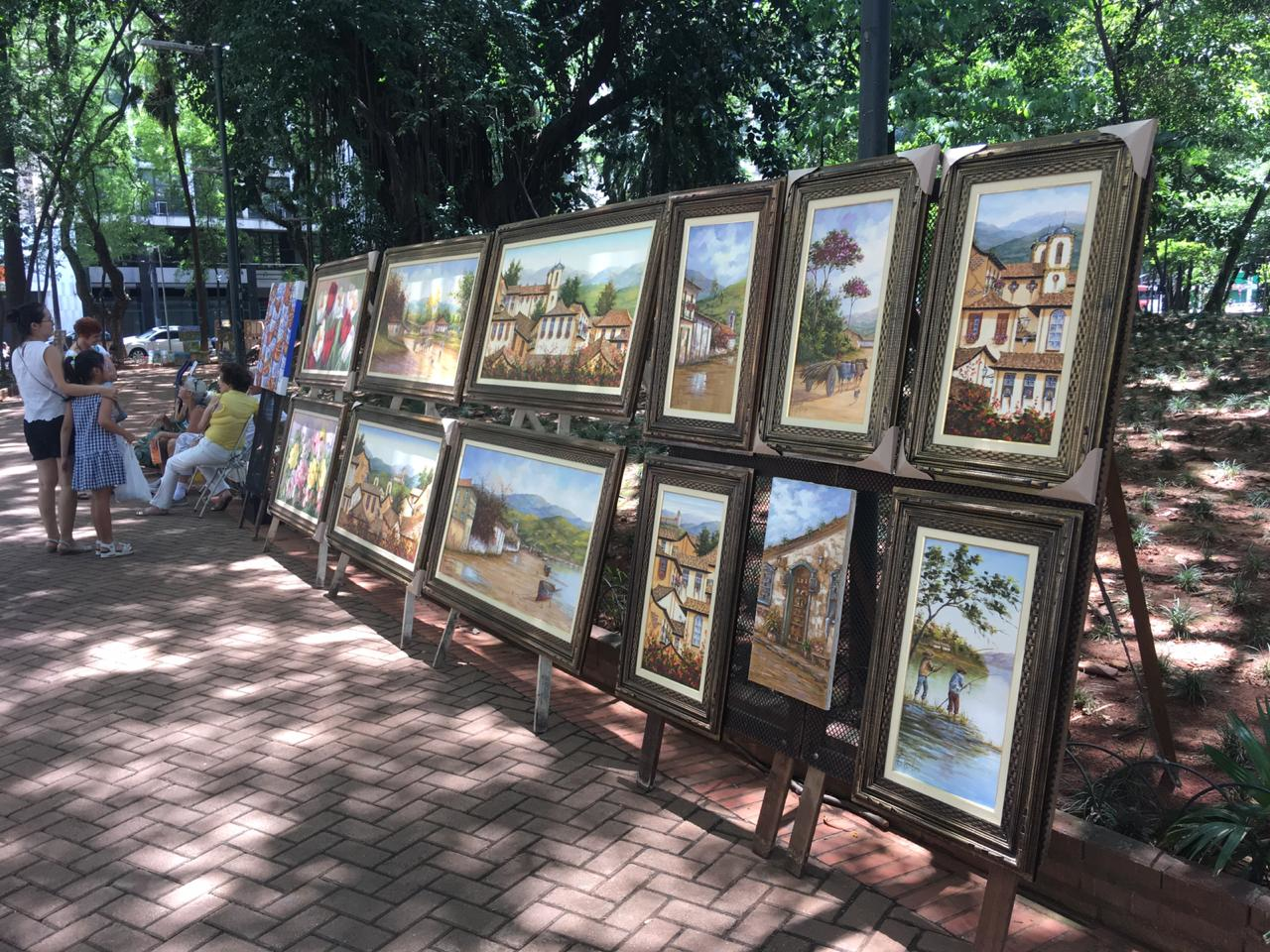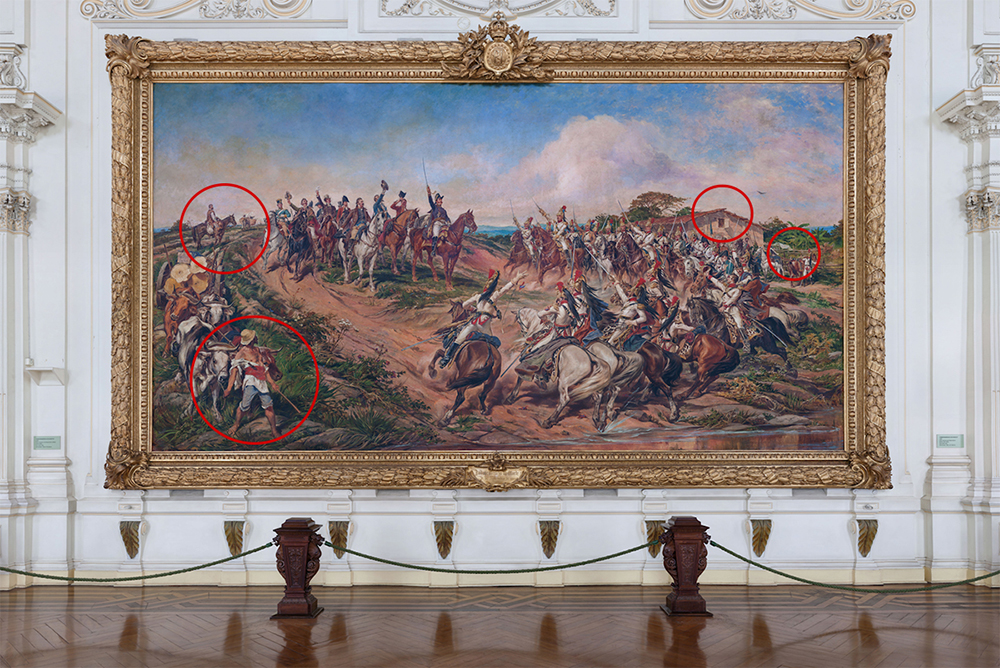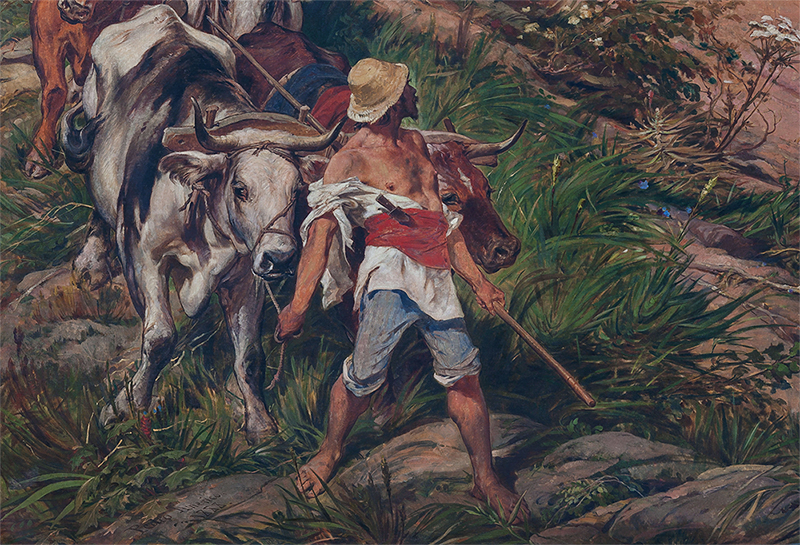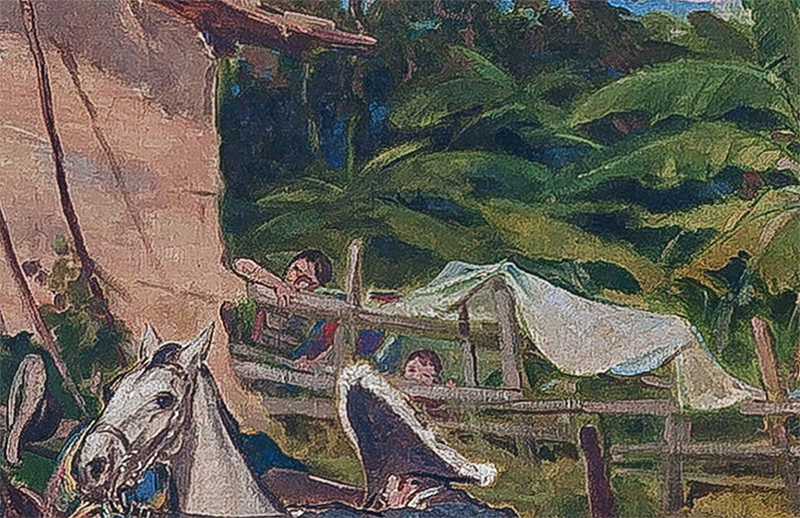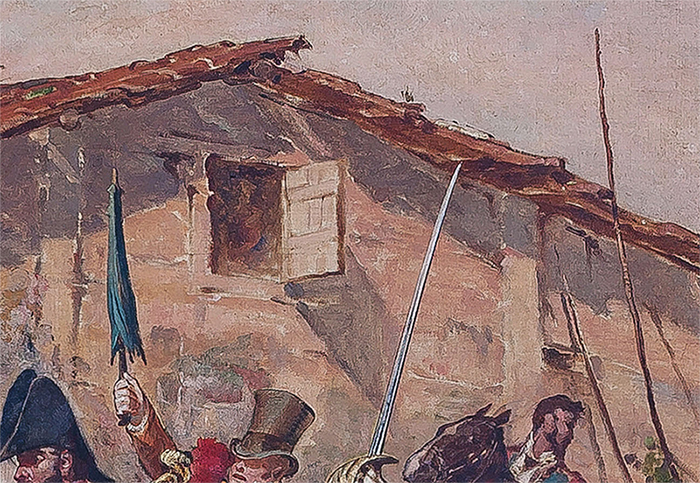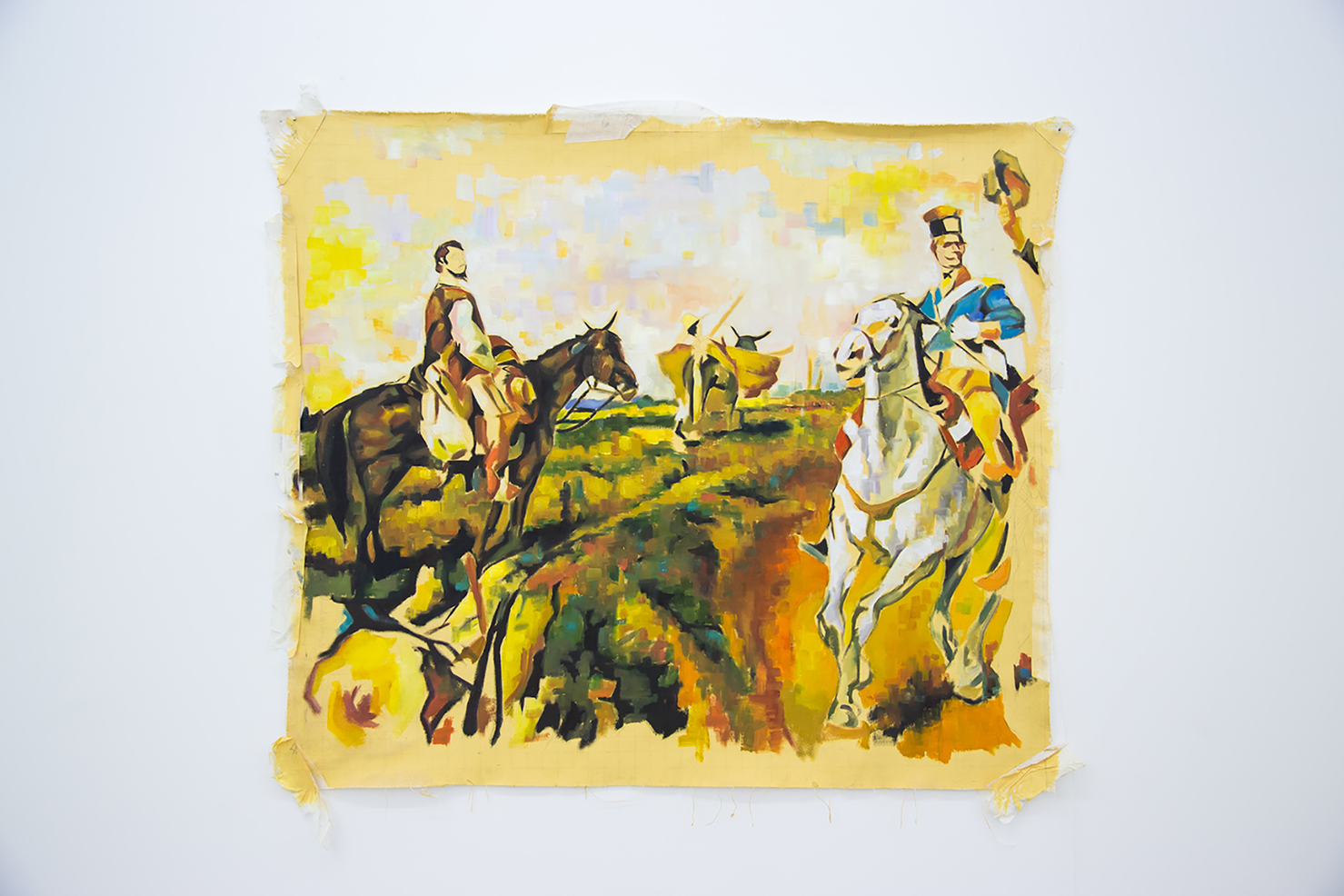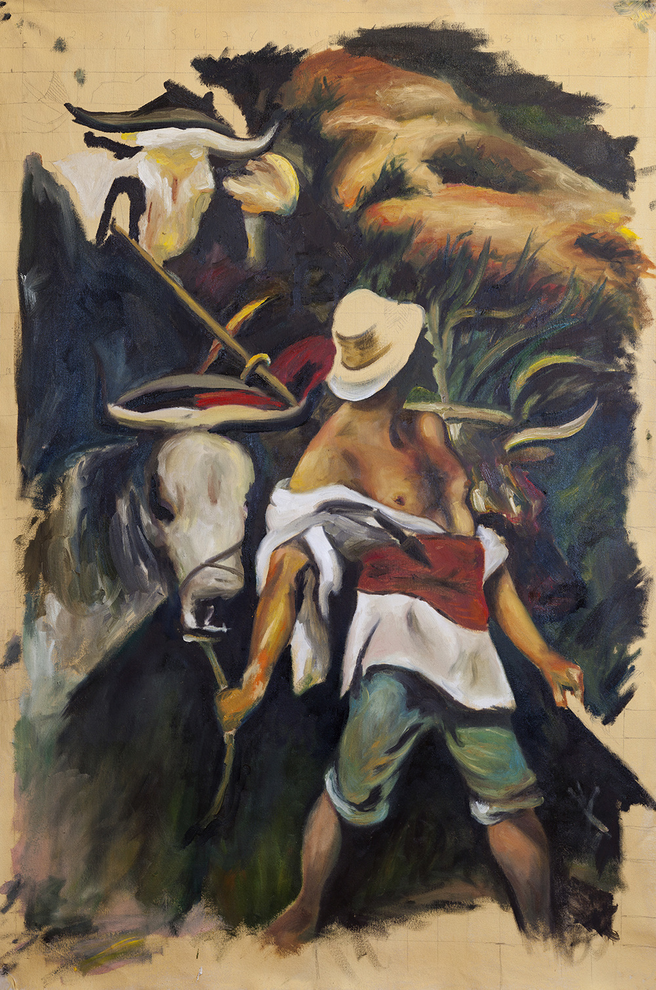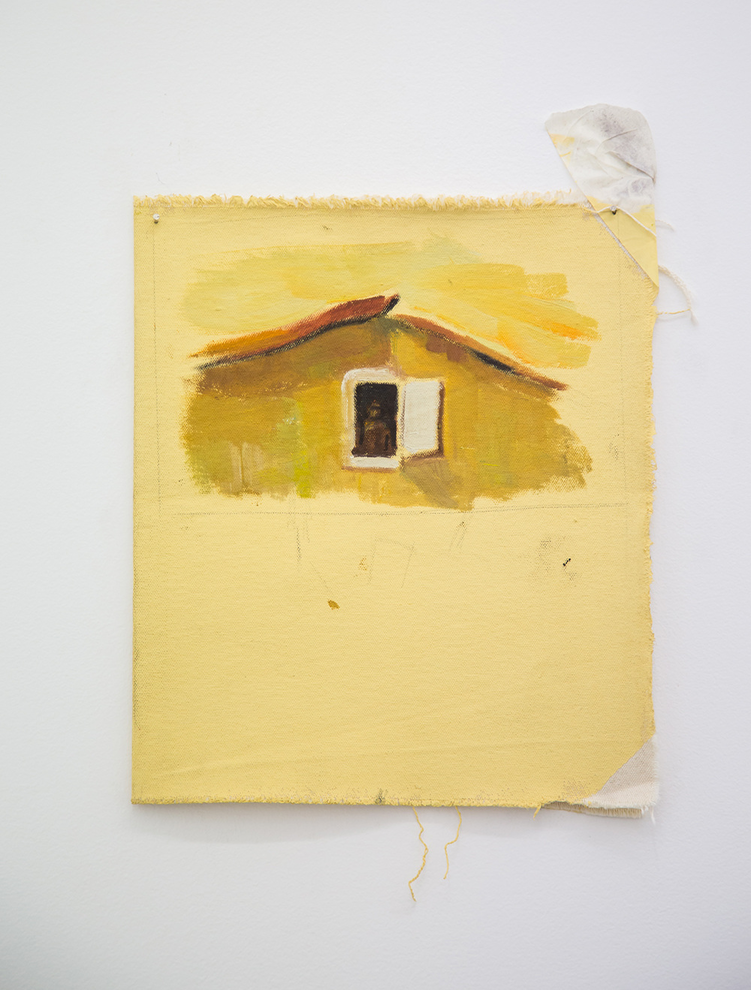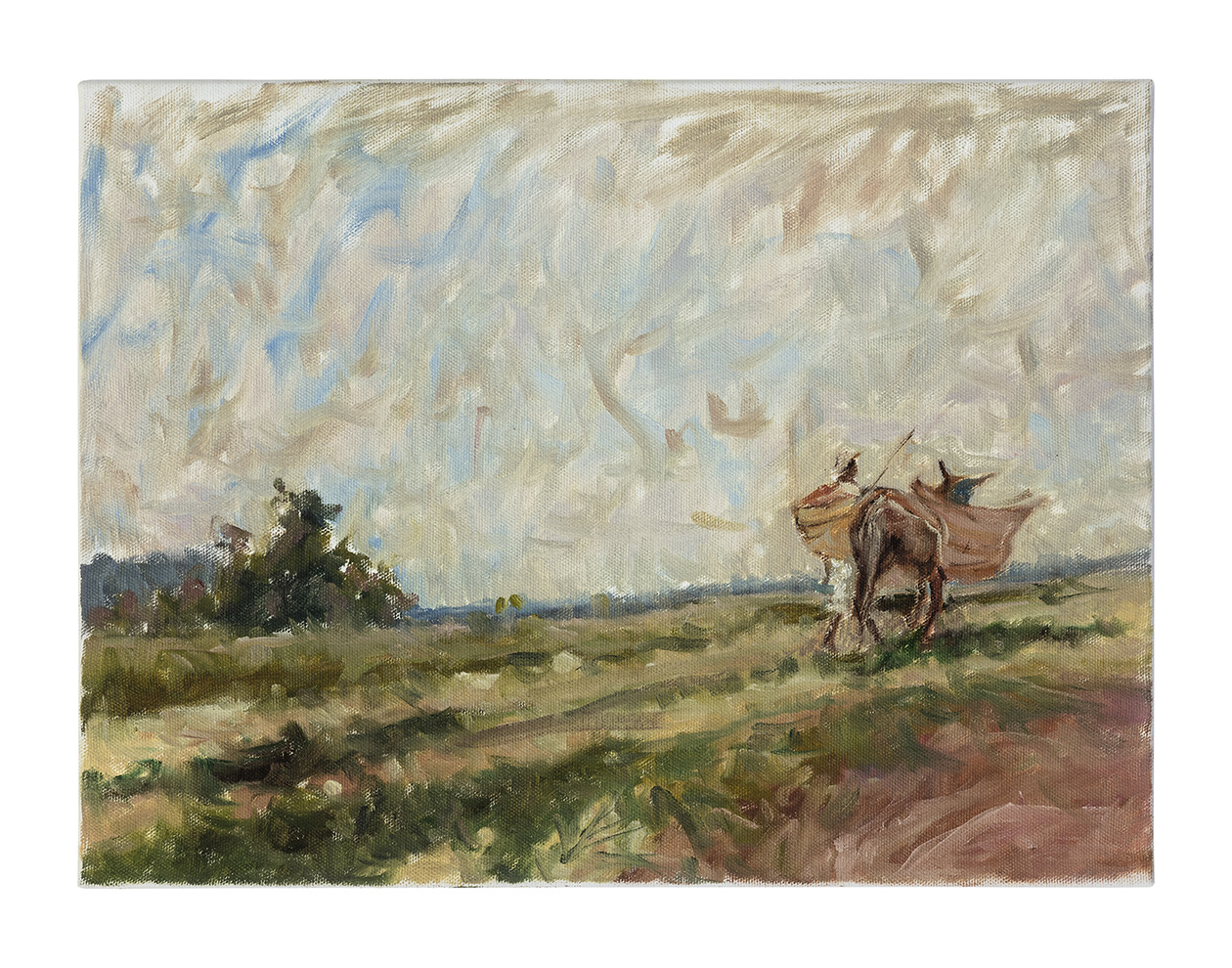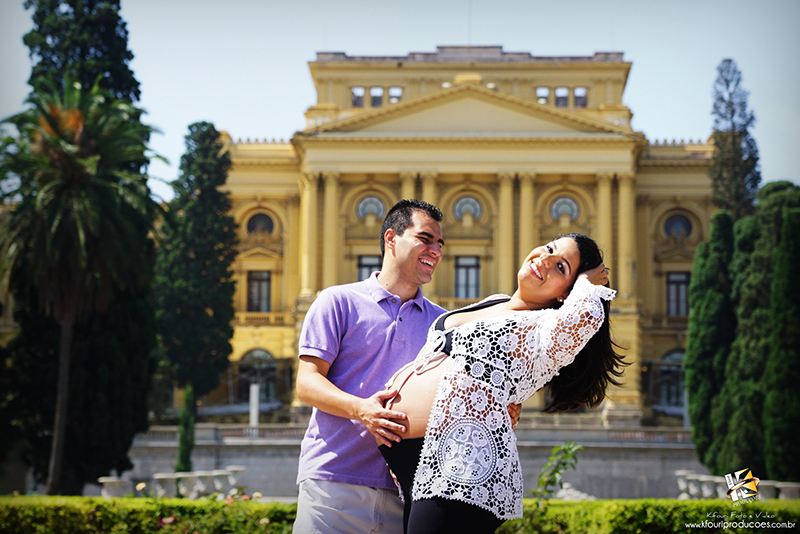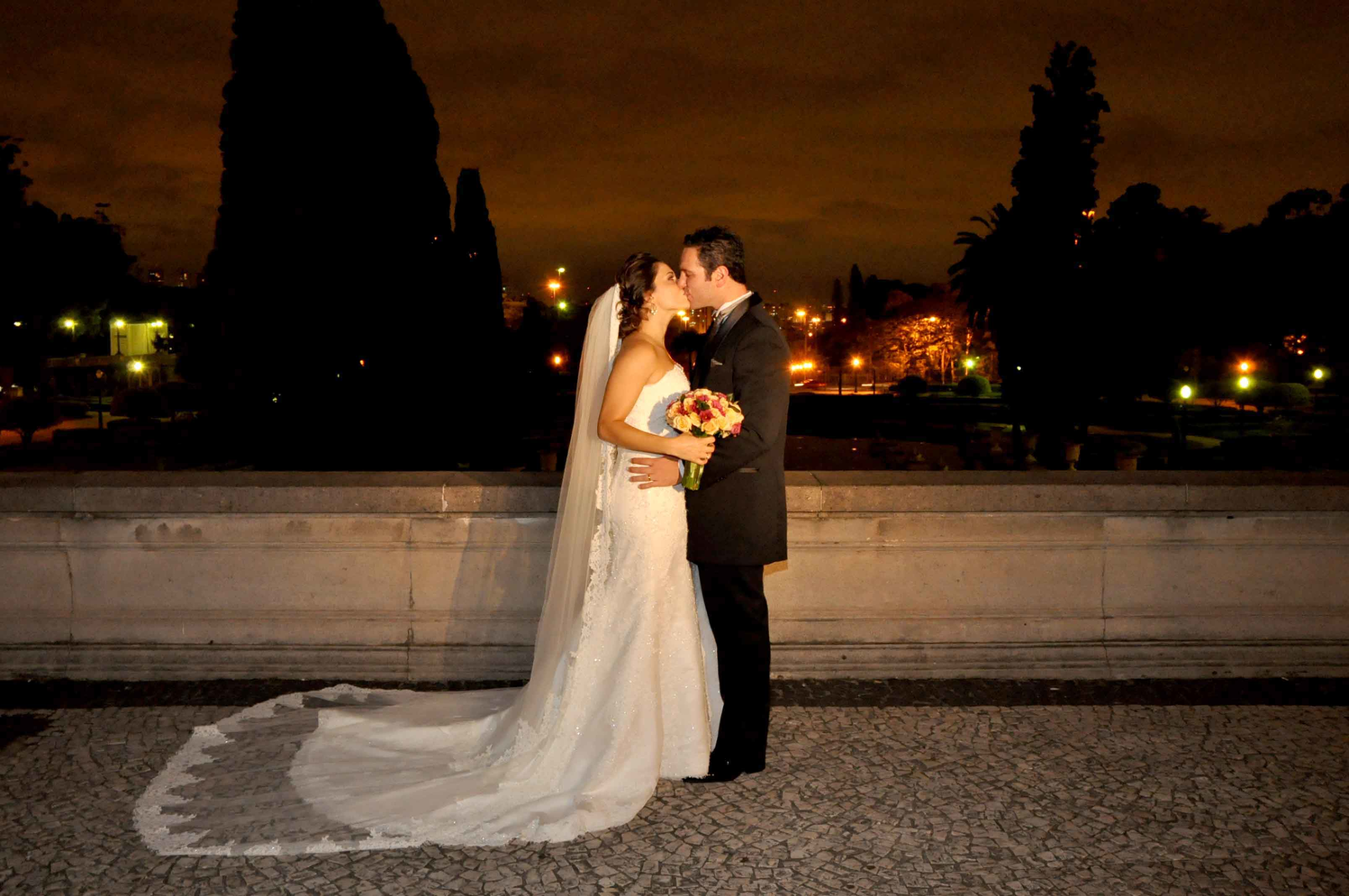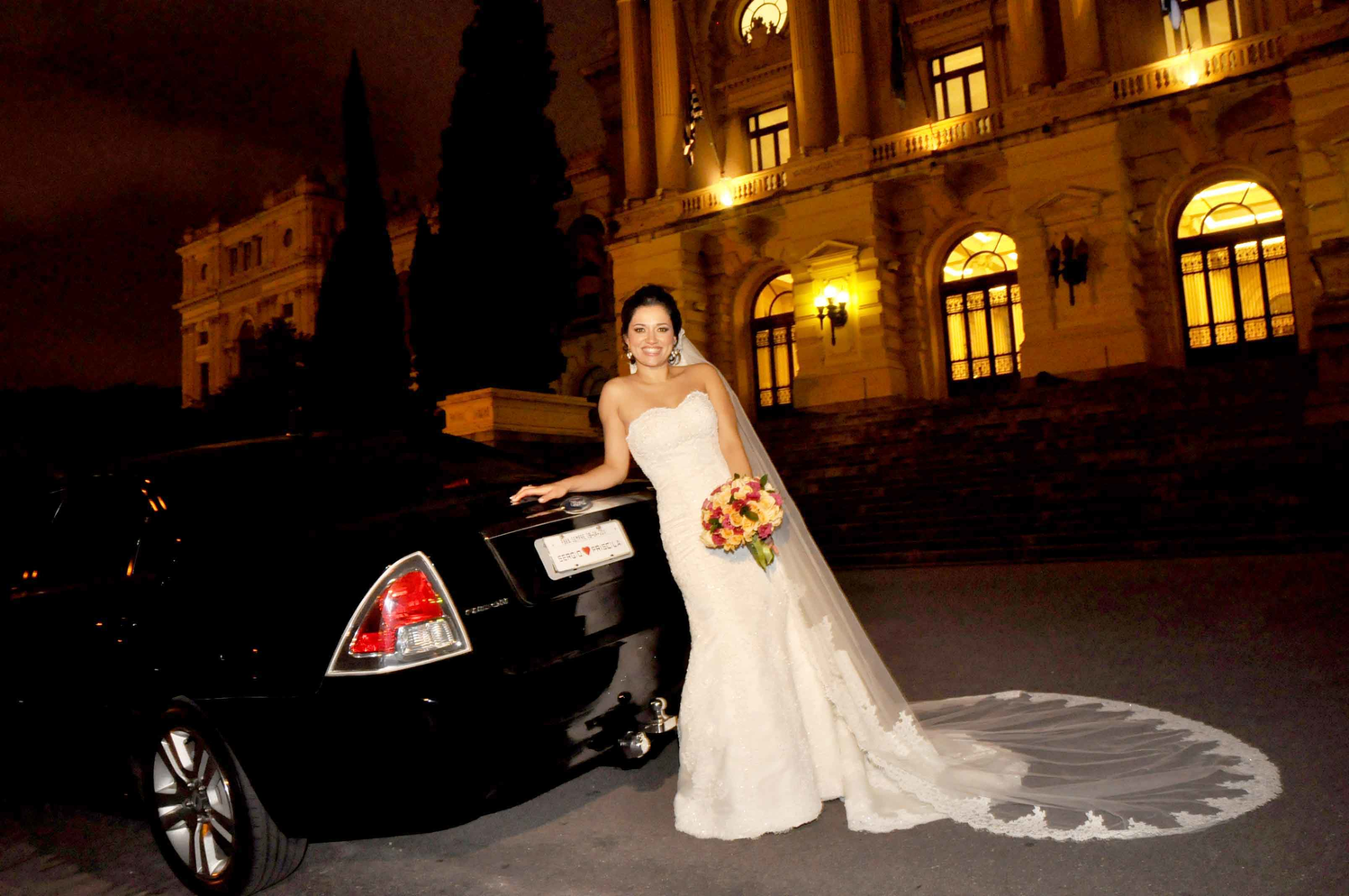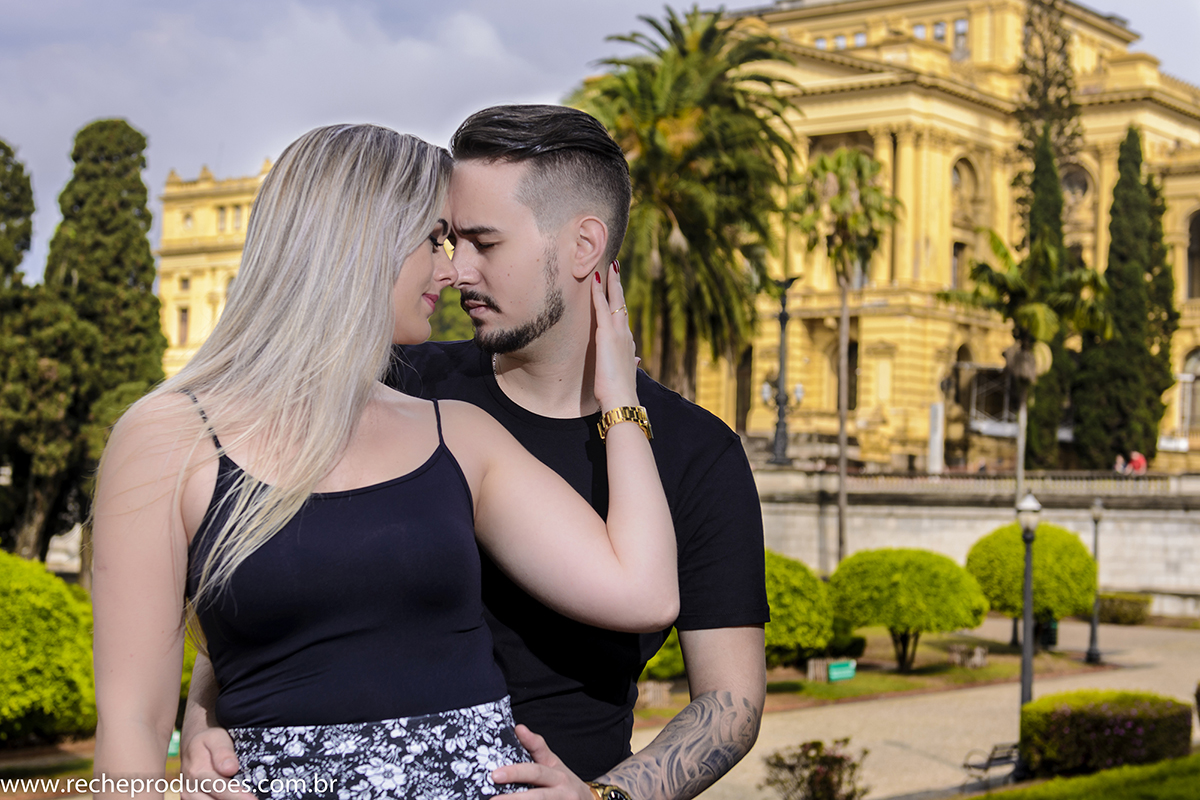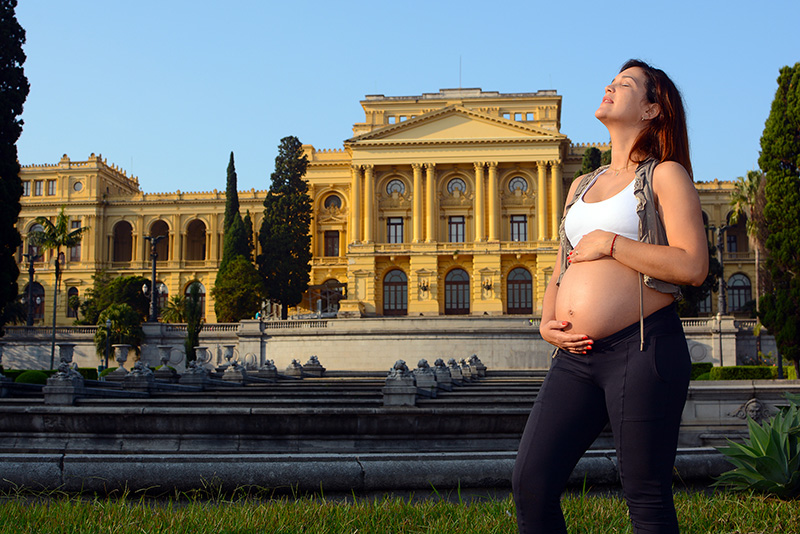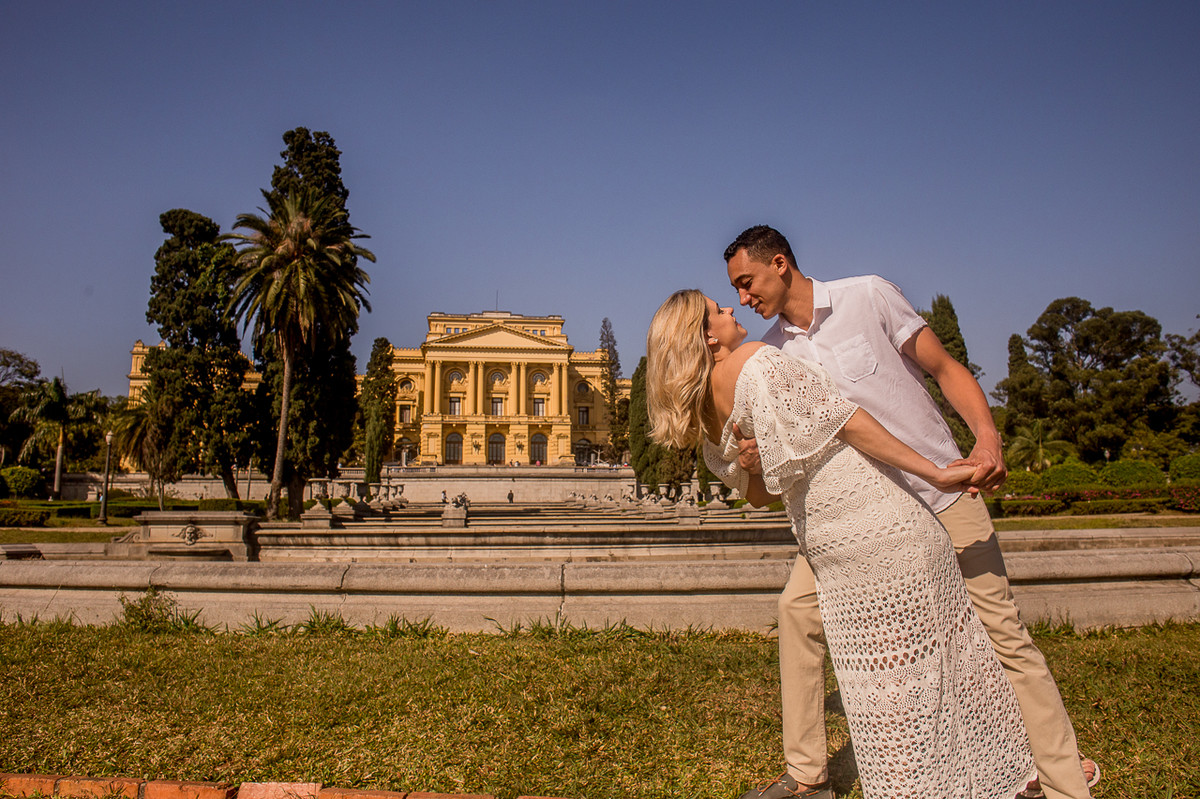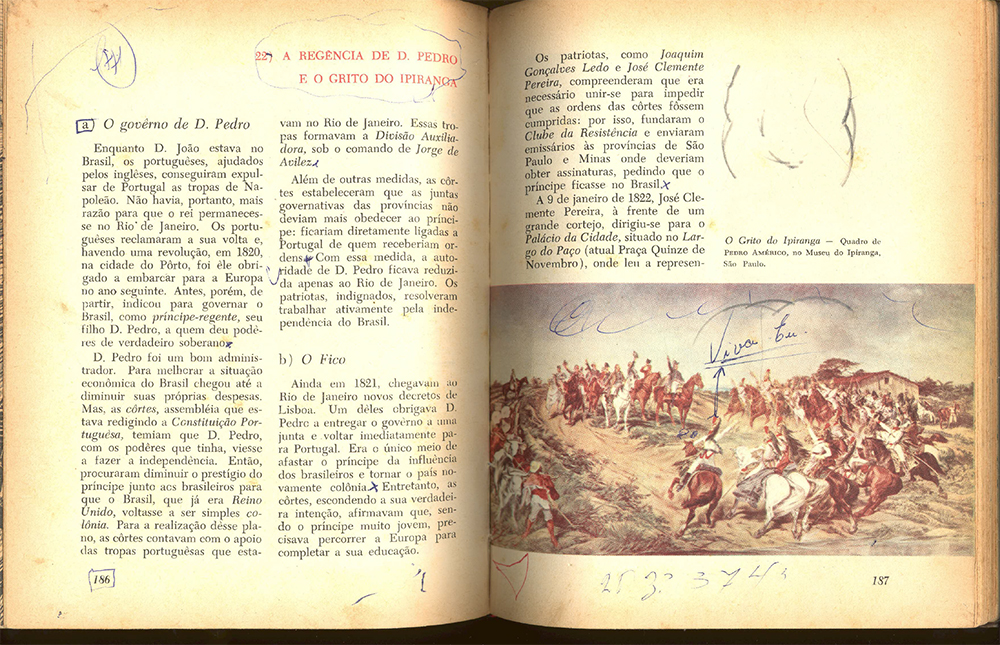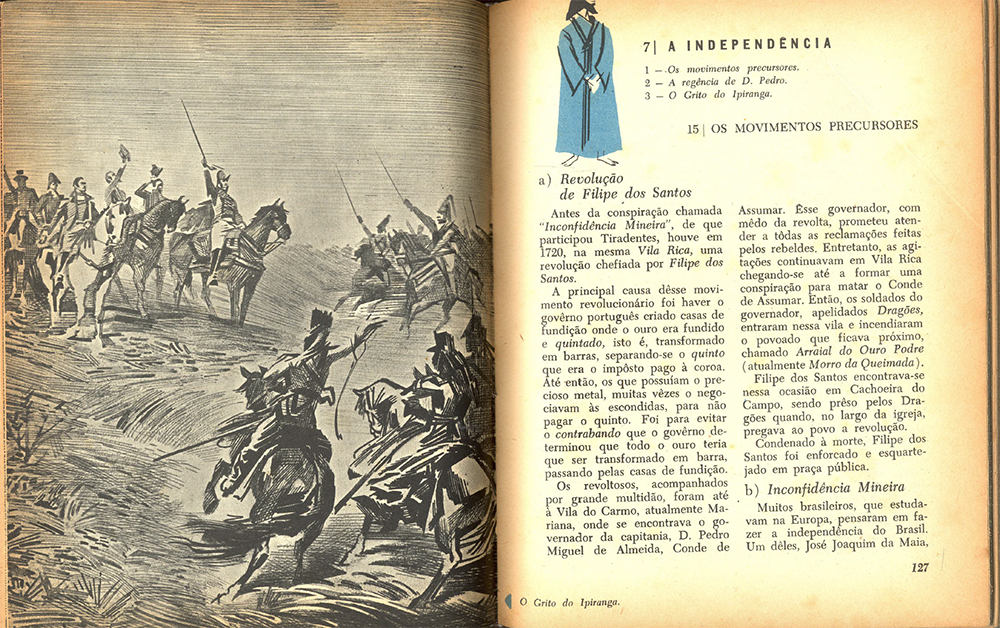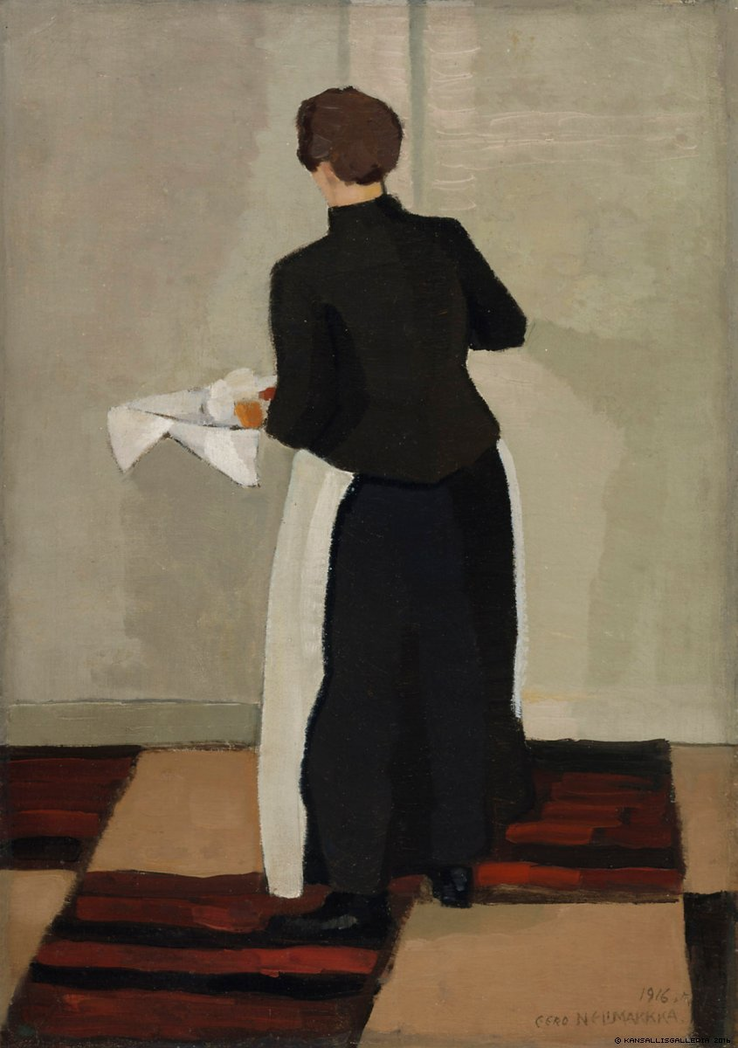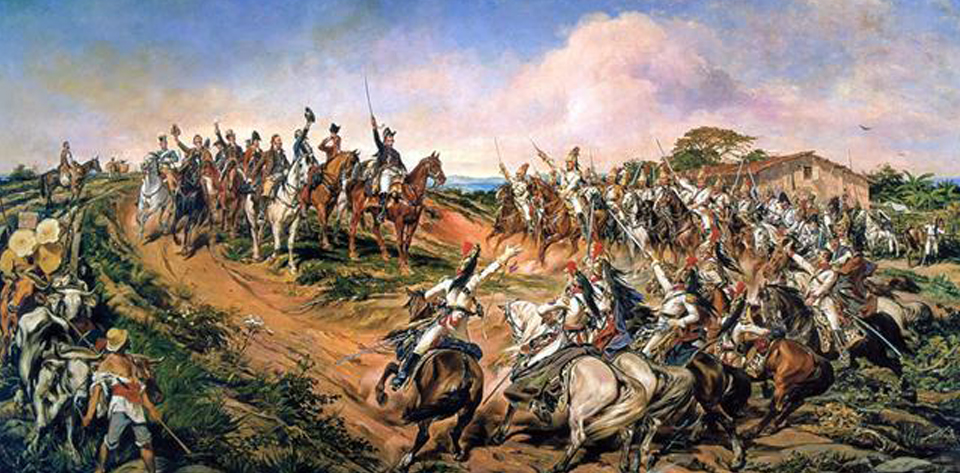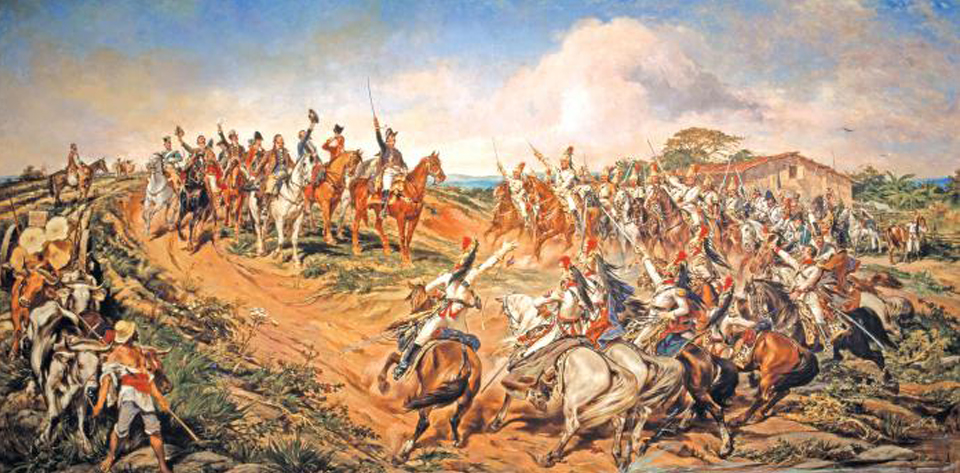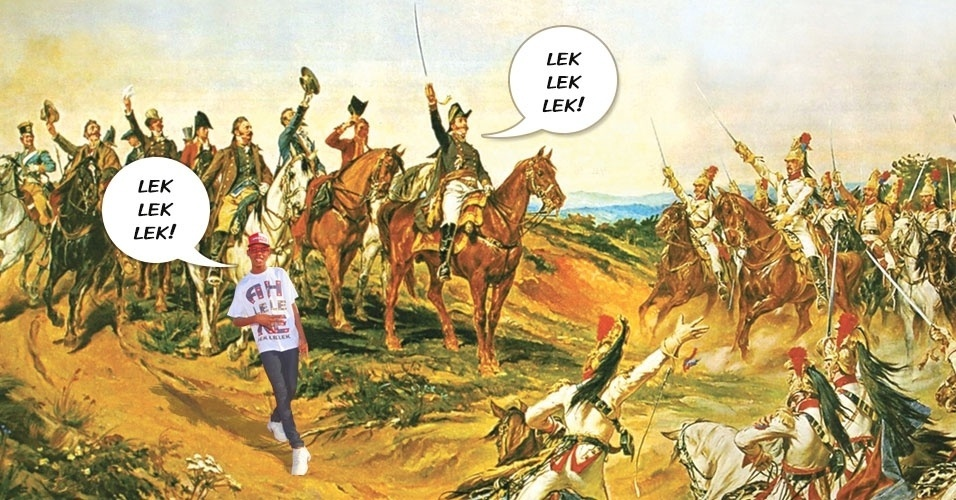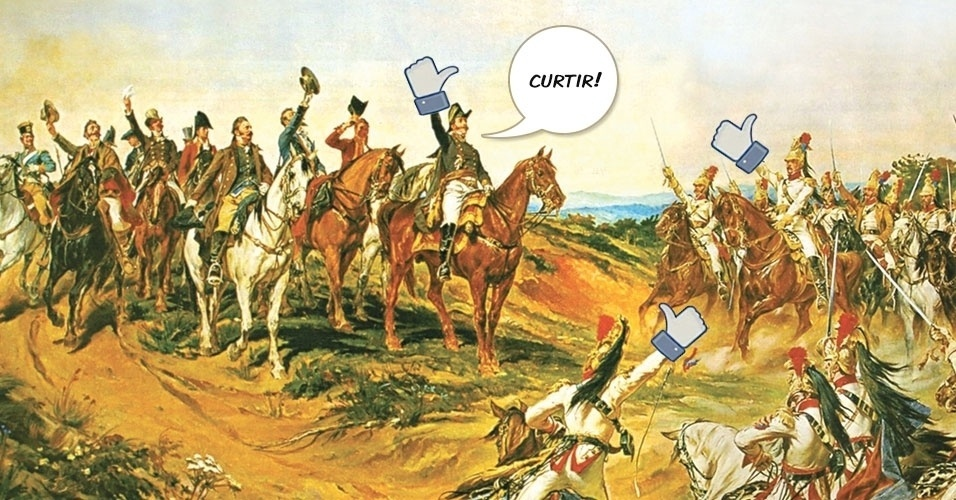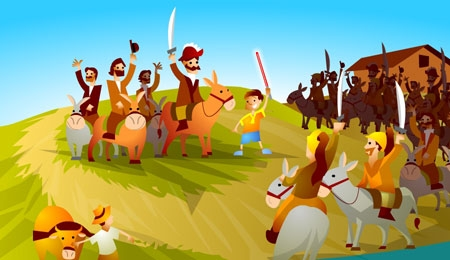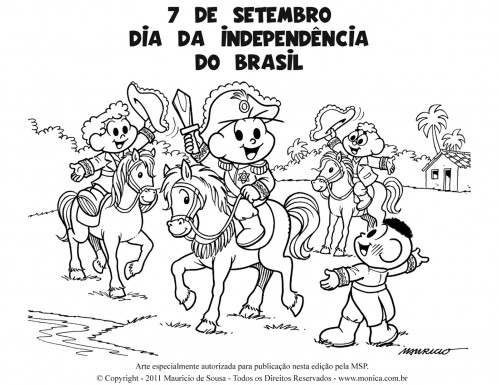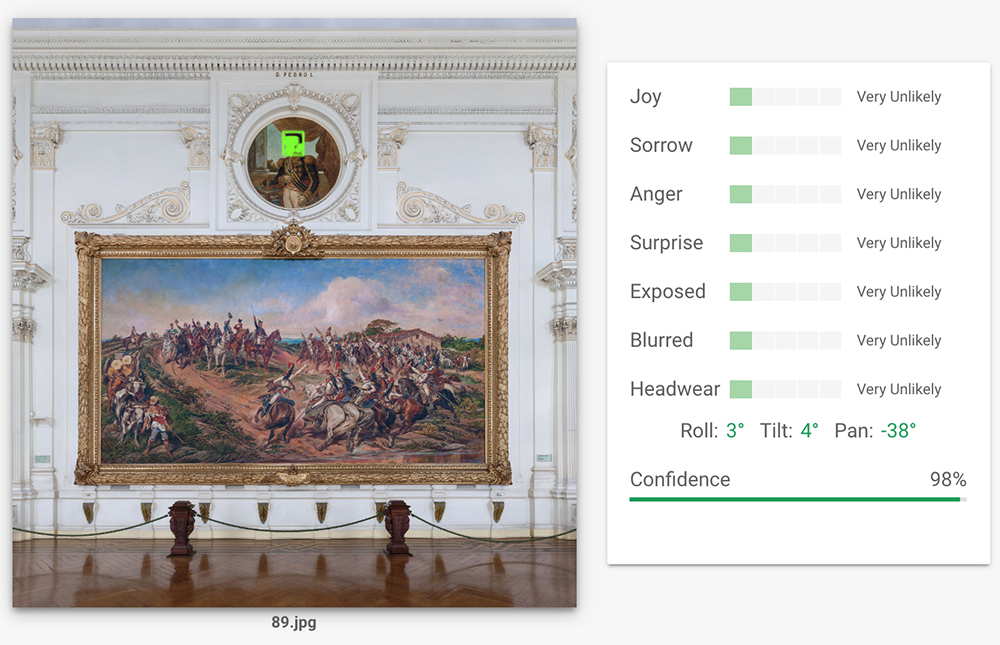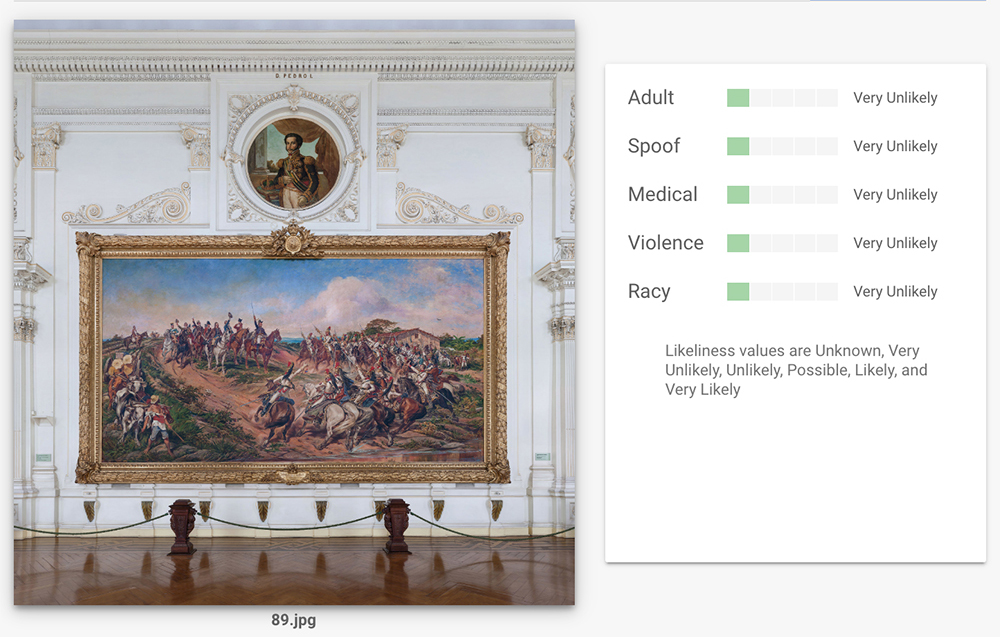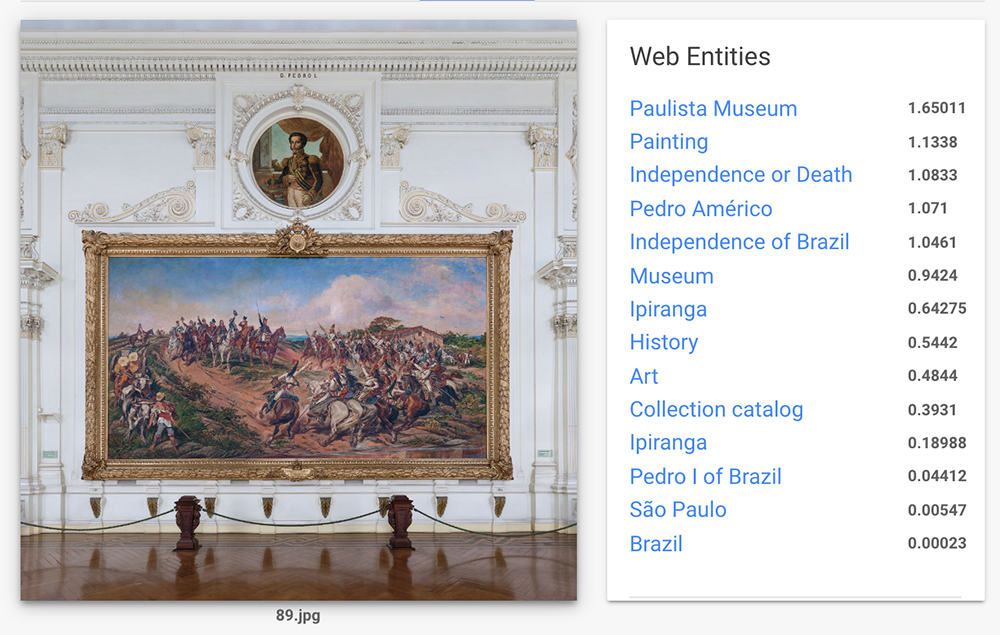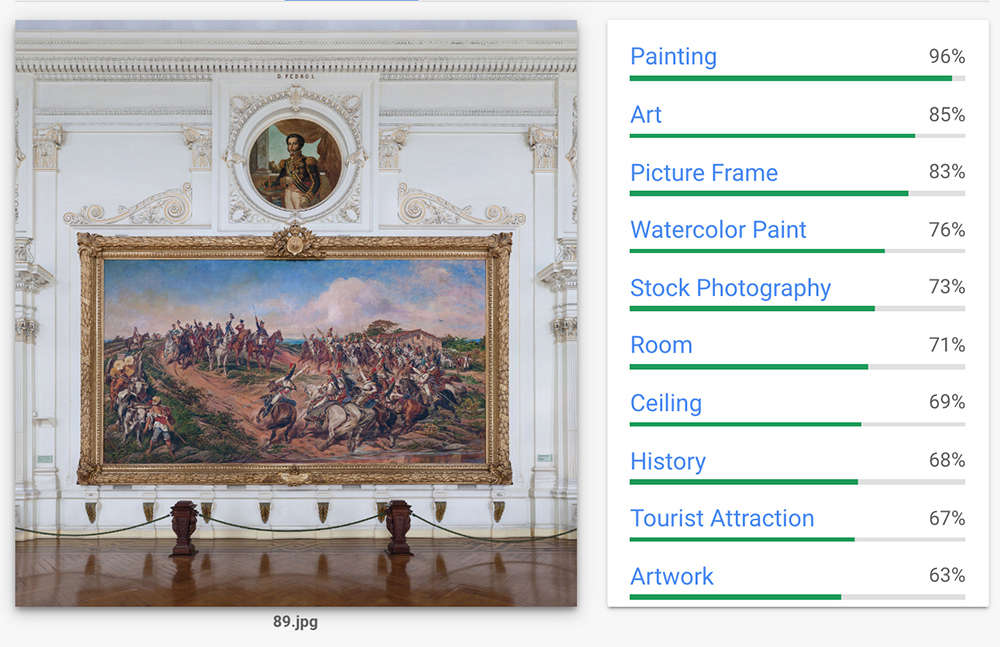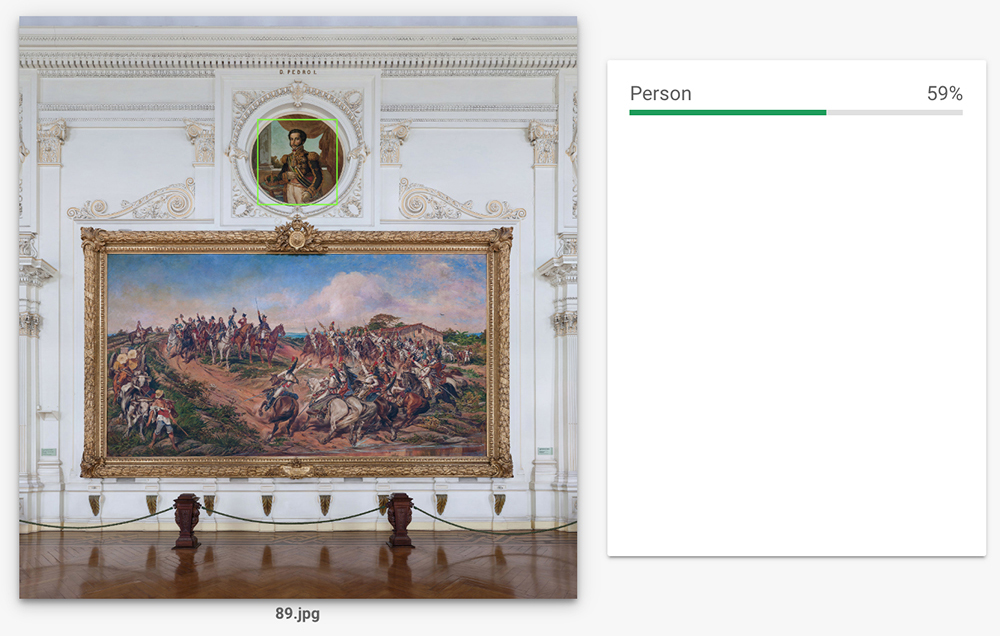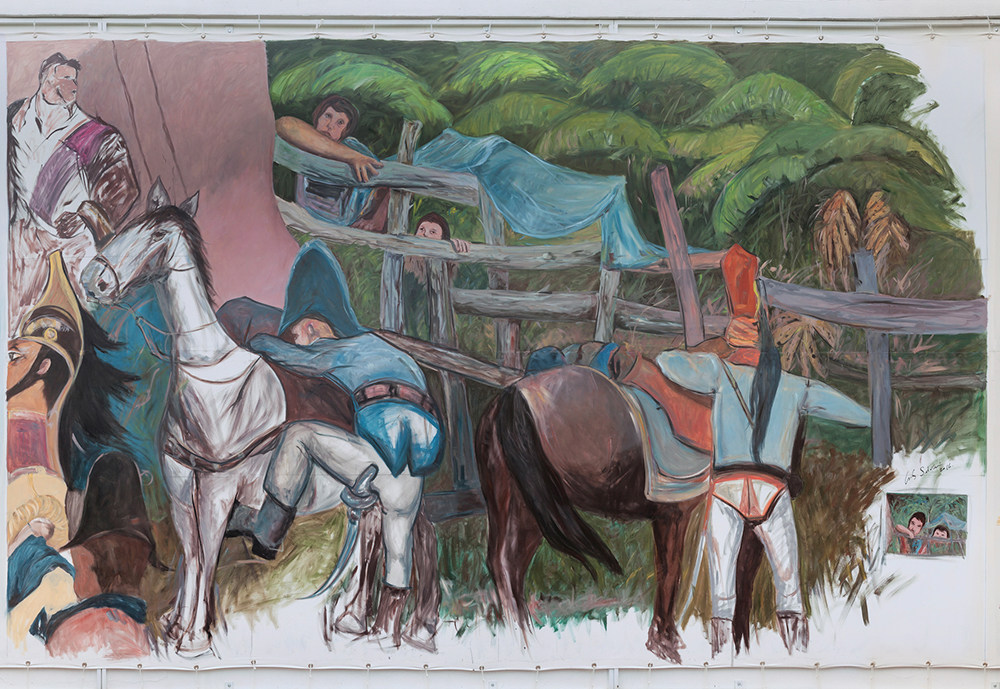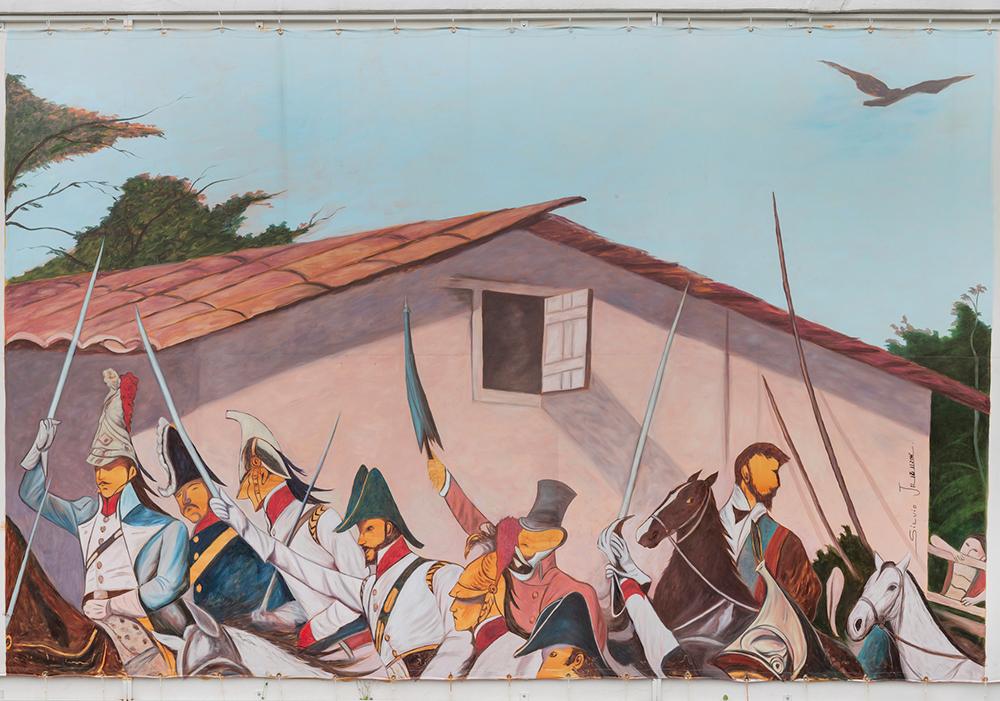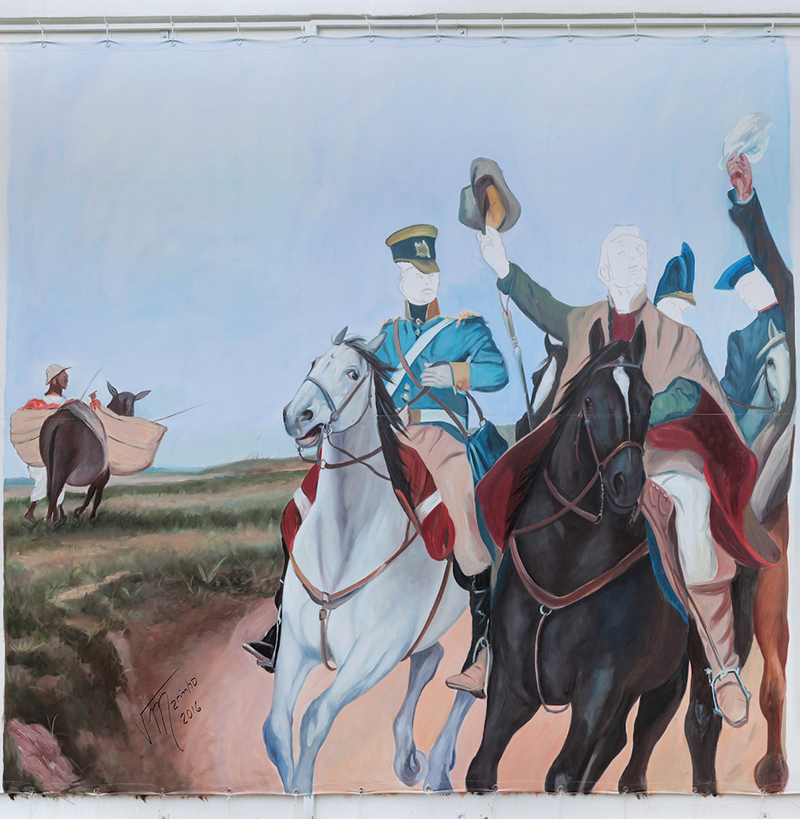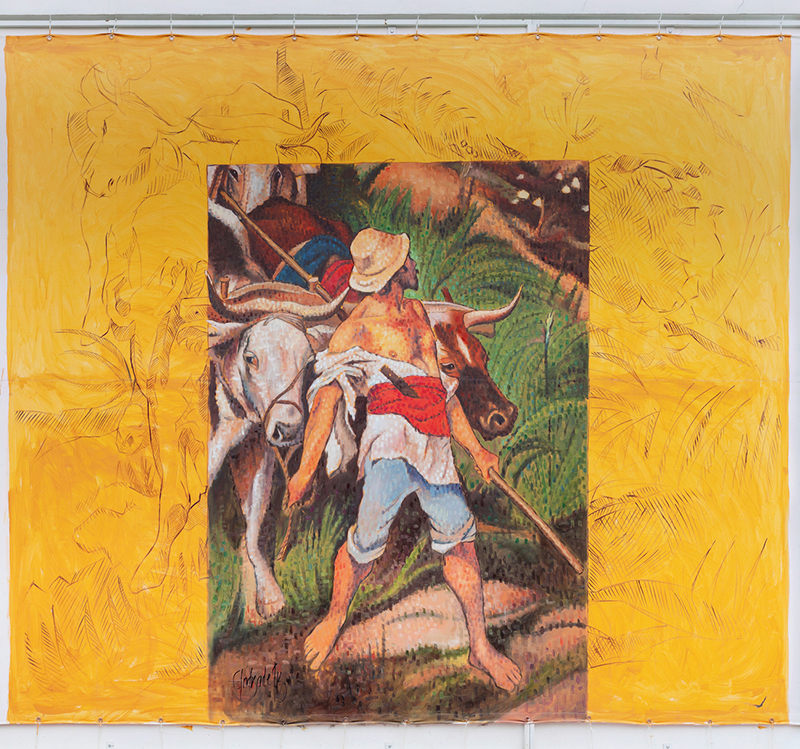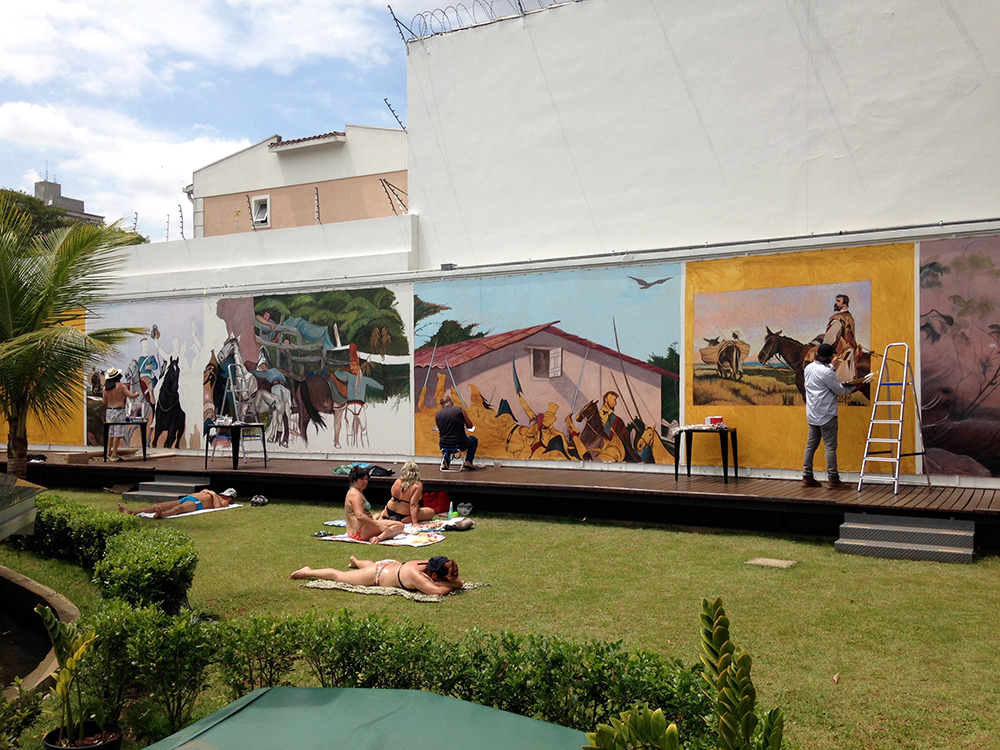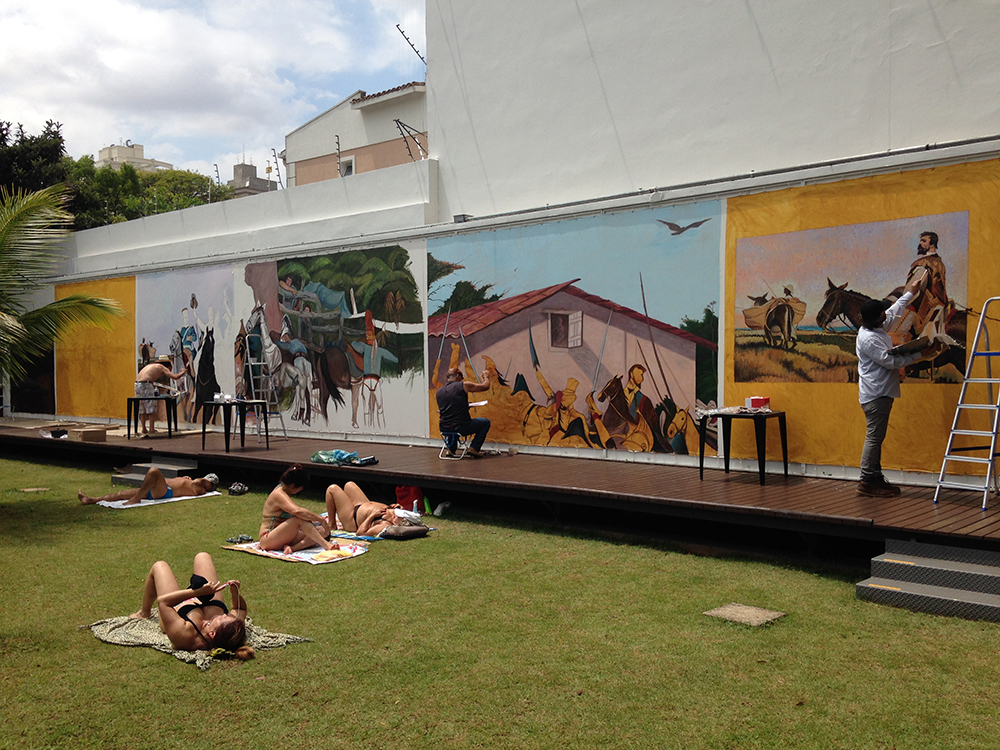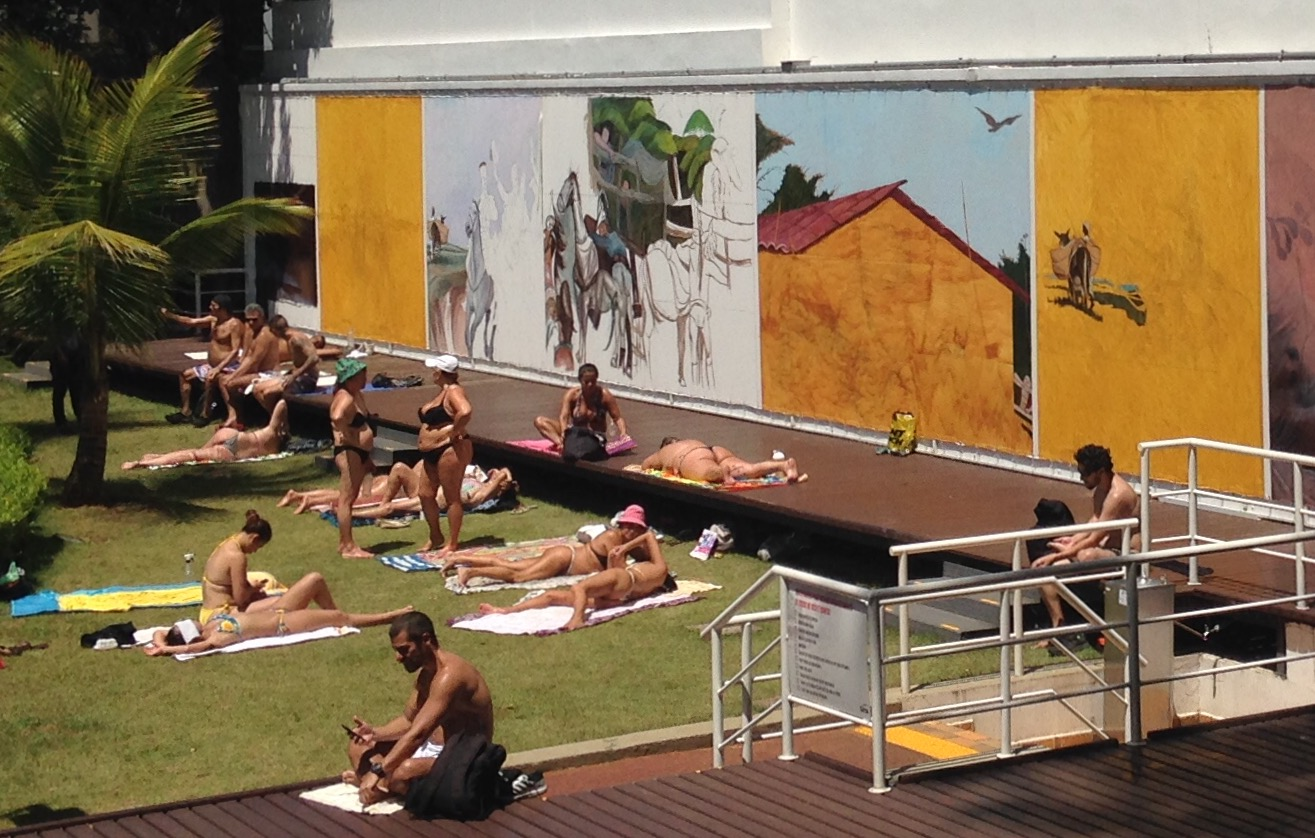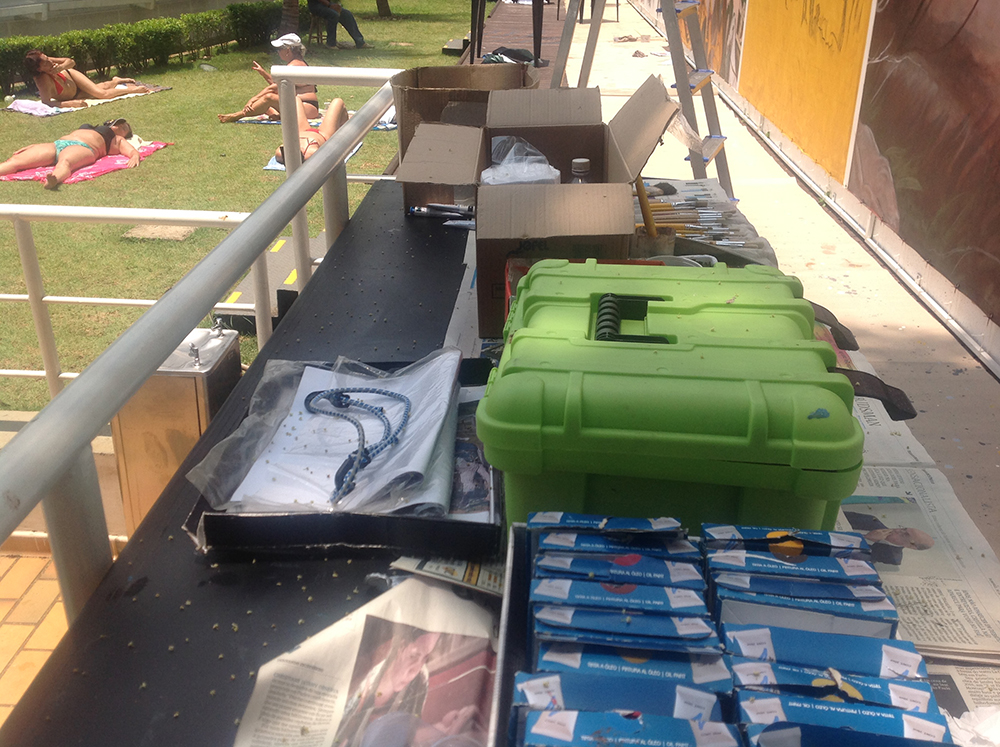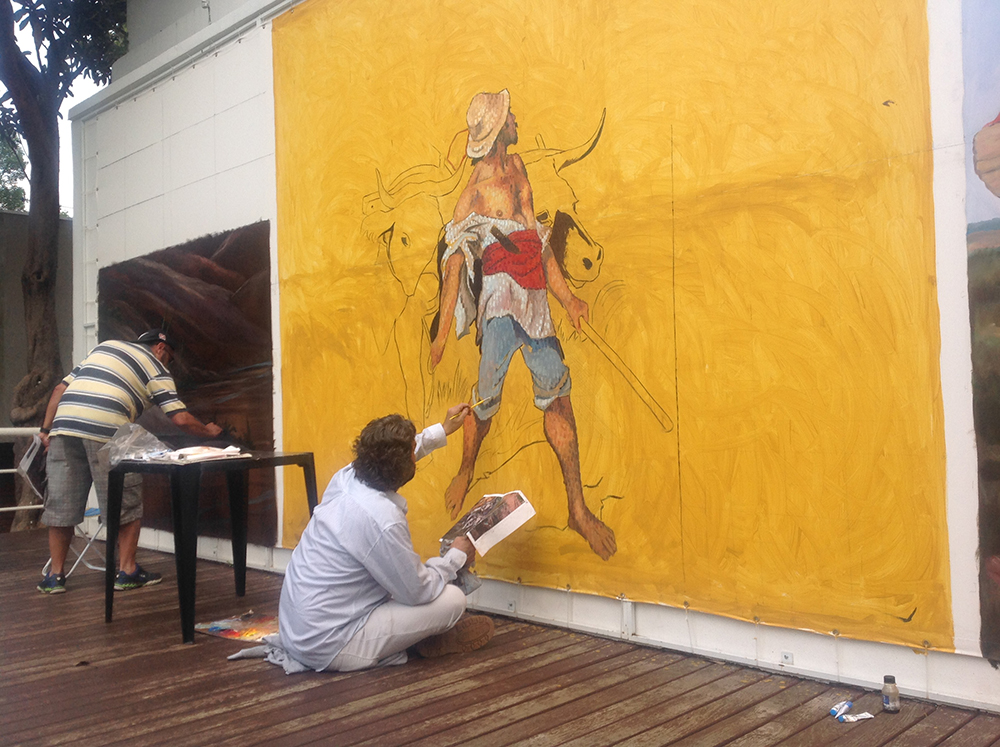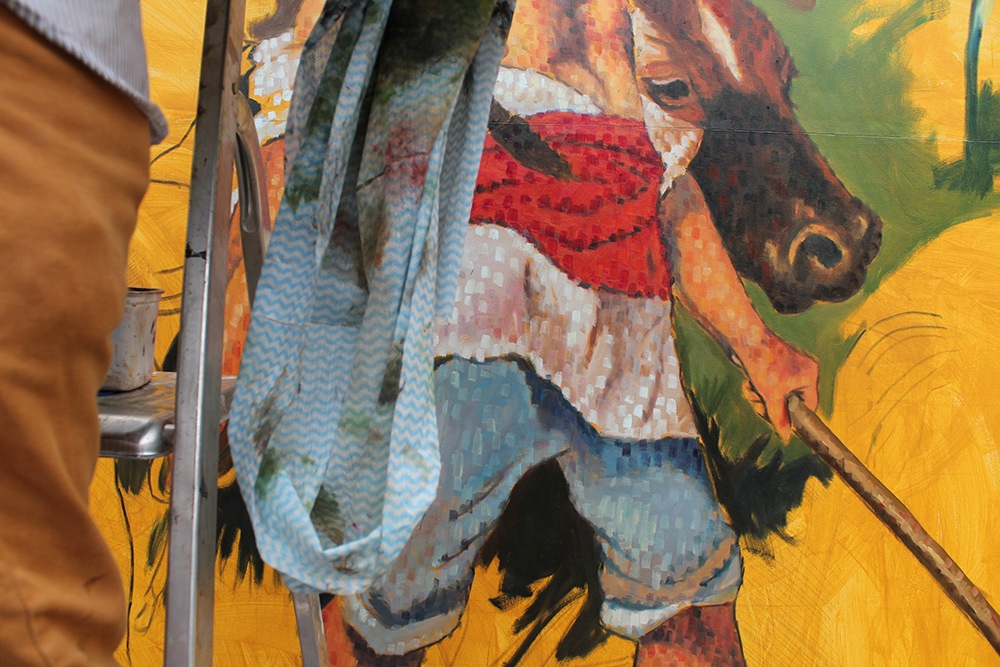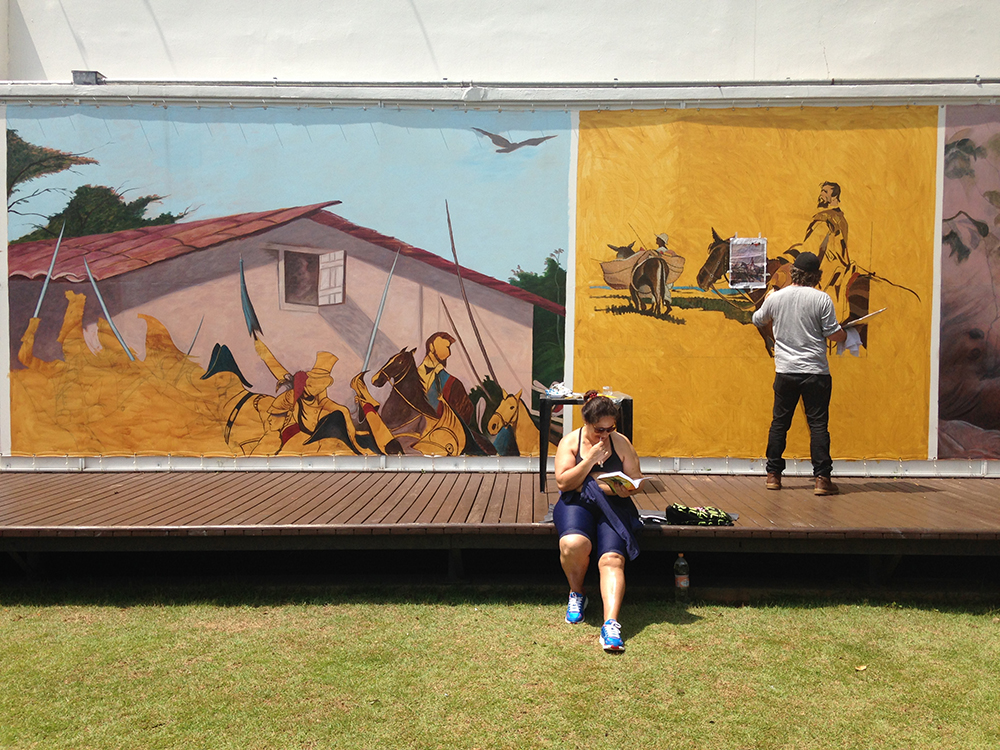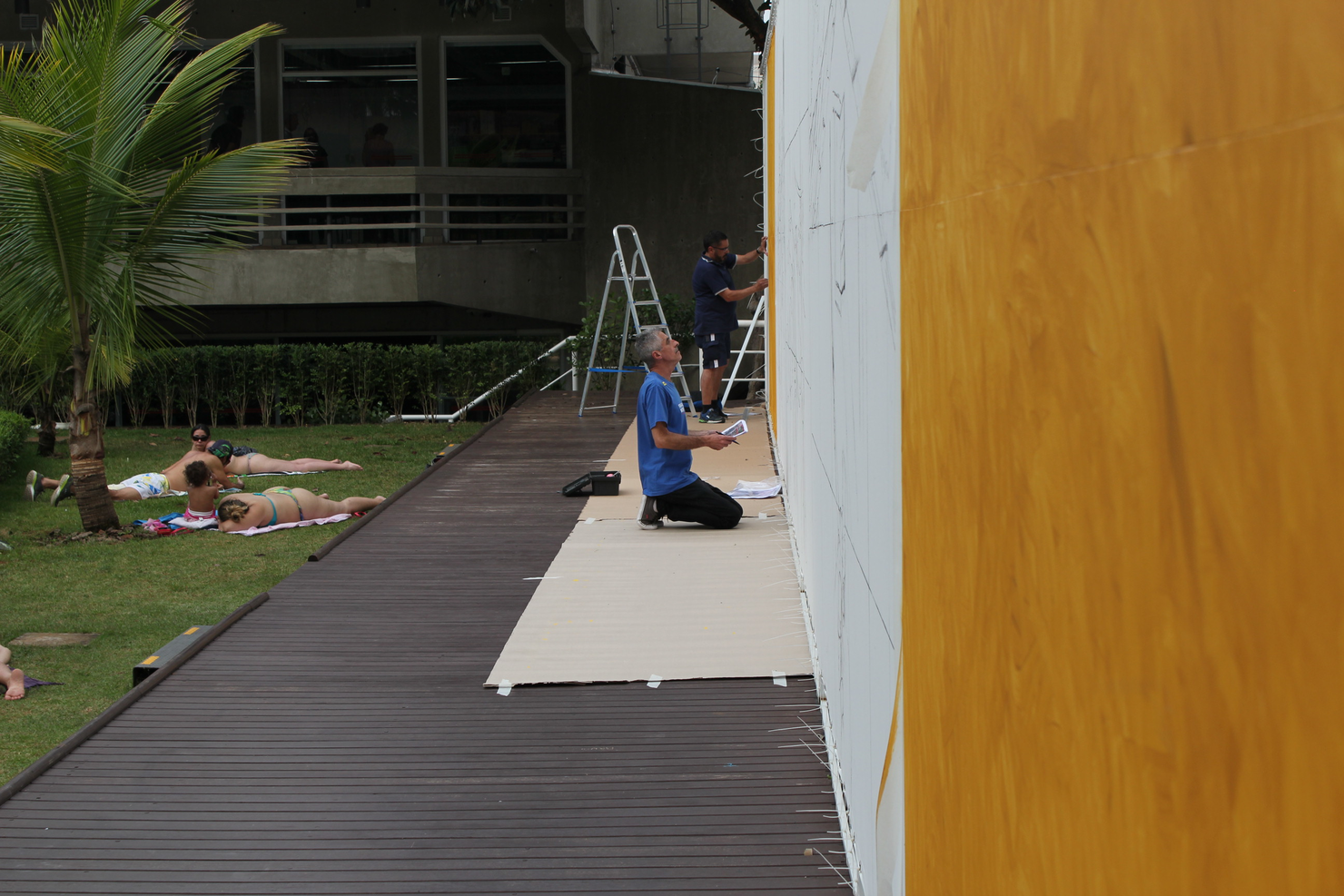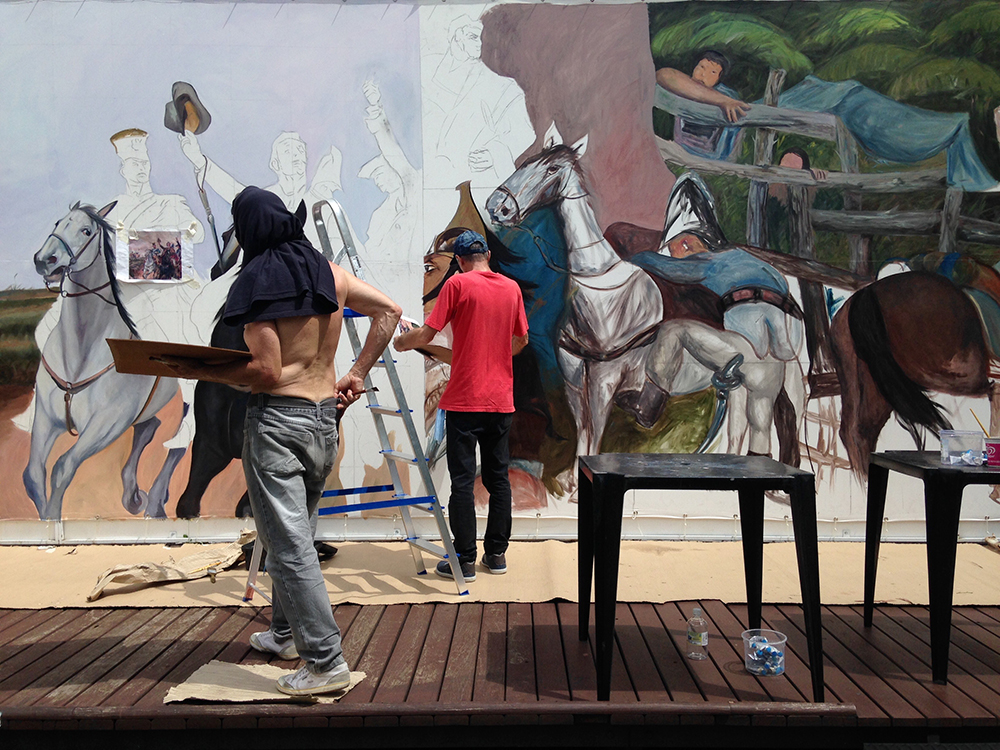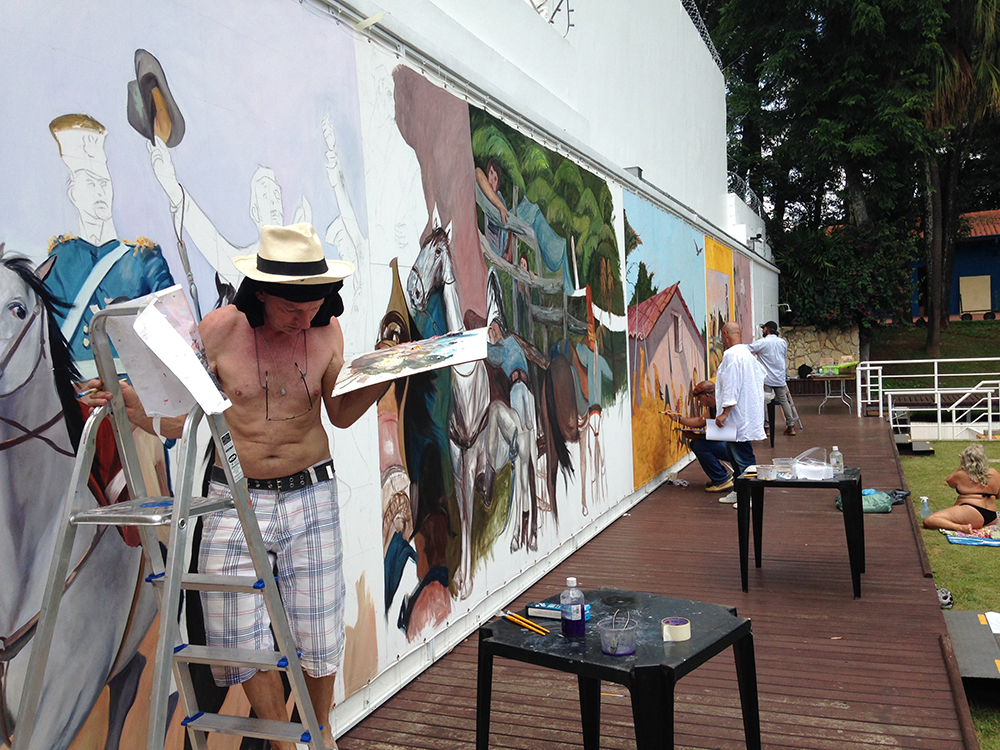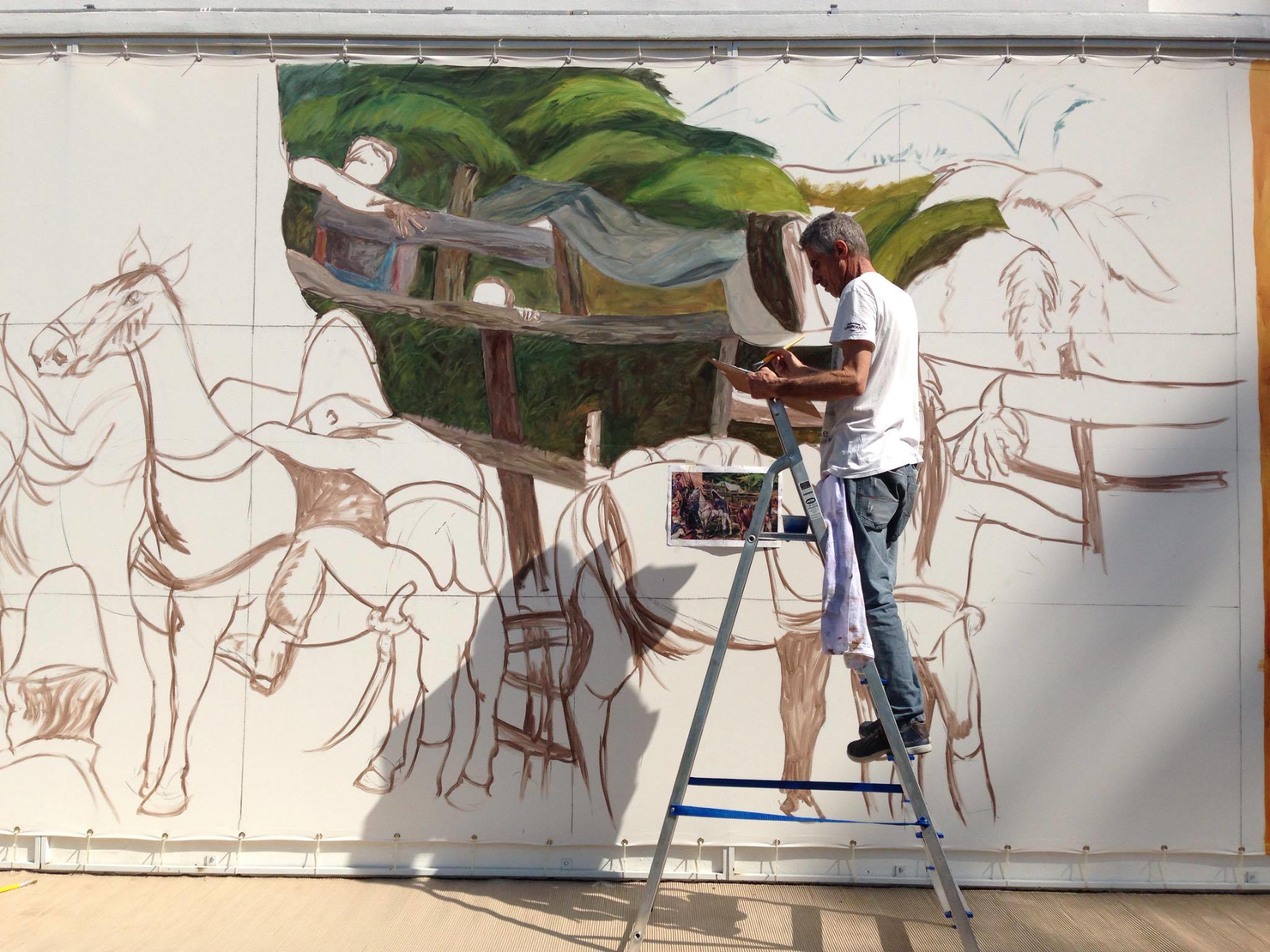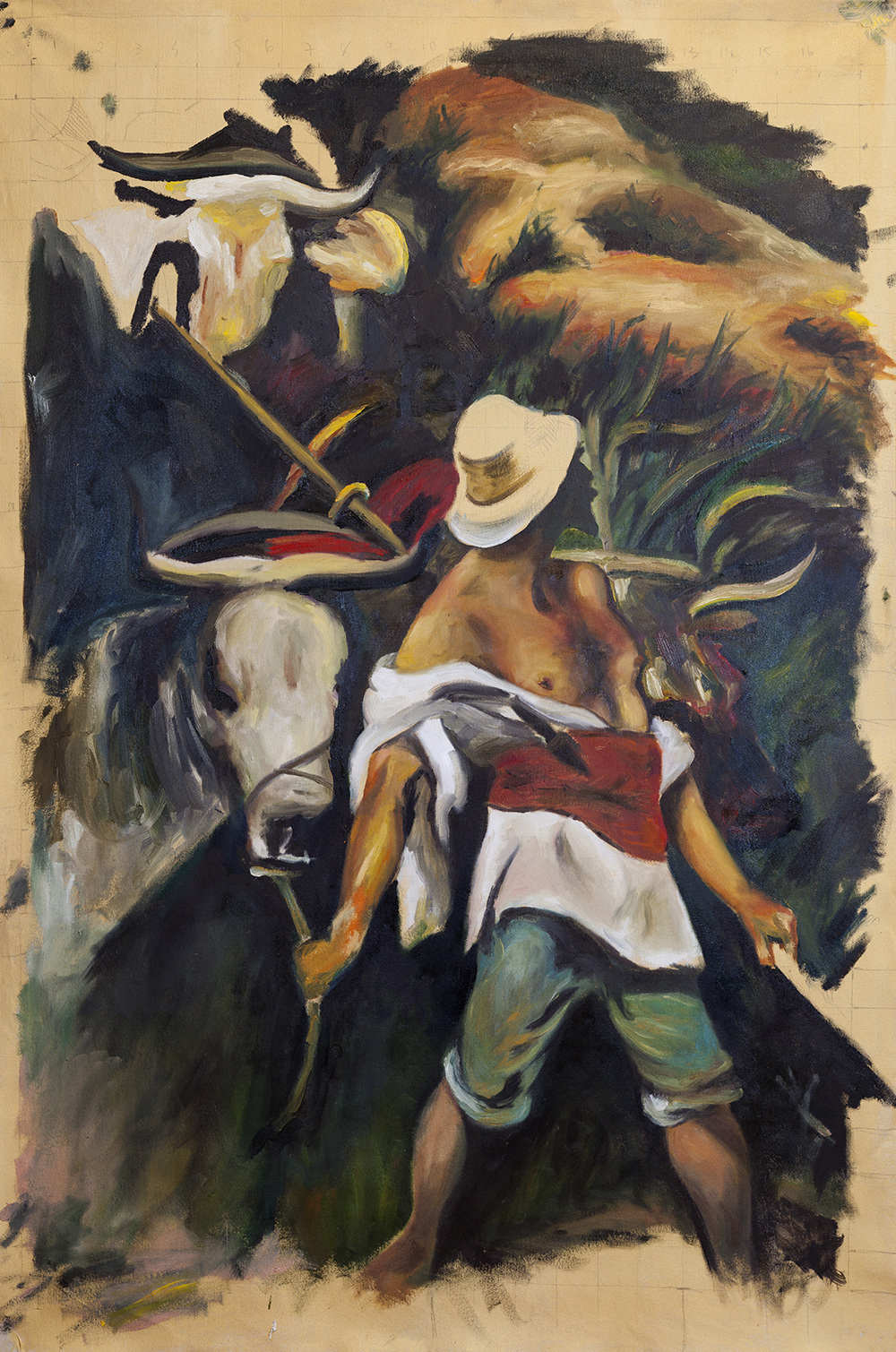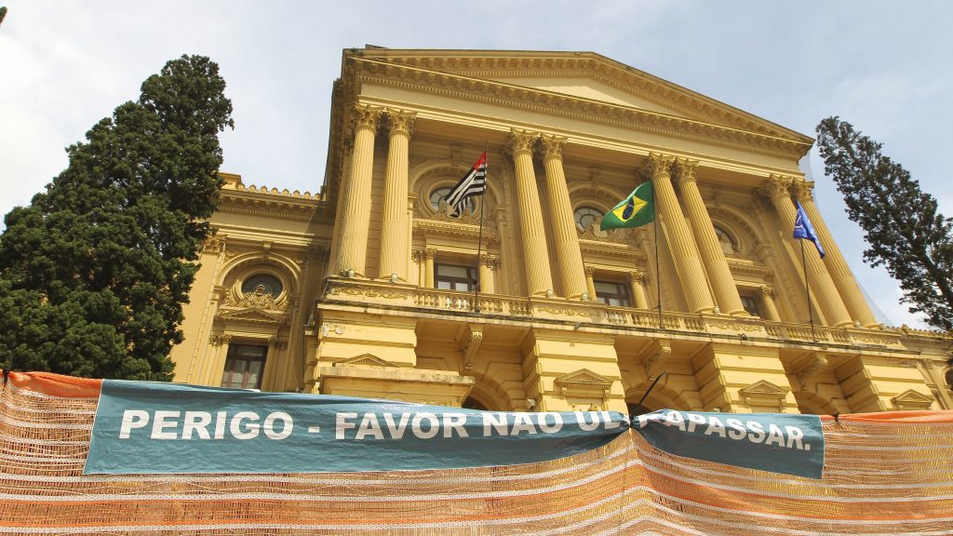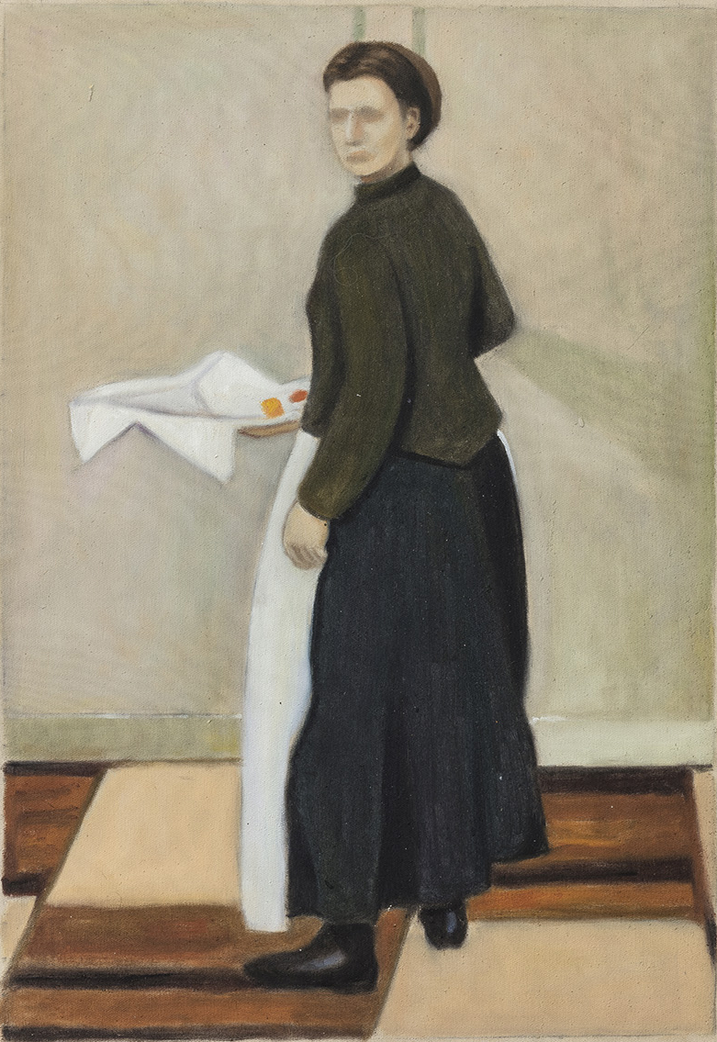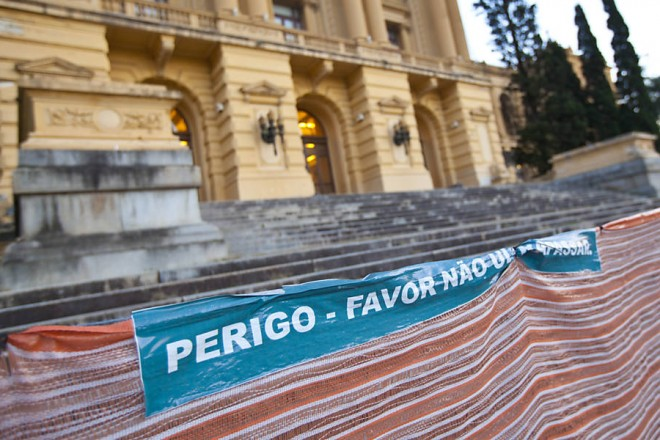First version of Independência ou Morte. A joint project with artists from Praça da República (São Paulo): Reginaldo Frazão, José Almeida, Carla Soares, Helena Trindade, Antônio Castro, Silvio Jr., Moisés dos Santos, Carlos Silvério and Marco Andrade Jr. Oil on canvas, 185 cm x 380 cm
Many of them did not know that the Paulista Museum was closed for renovations. When one of the artists at the square learned that one of the museum’s main artworks would not be available to the public for years, he reacted saying: "Something needs to be done about that." This created the ideal context for me to extend them the invitation to jointly create a new version of Independência ou Morte. Ten artists accepted the challenge.
The painters at Praça da República gradually understood that we would not have the means necessary to create an exact replica of the painting. This fostered a rich discussion on how to balance the various compositional layers of the image in formation.
This first experience showed the possibility of carrying out projects capable of bringing together artists from the contemporary art field and artists from the more traditional, academic field, in ways that are much more complex than merely commissioning from a distance.
The collective painting process lasted four months and went far beyond attempting to reproduce a famous painting. In fact, we formed a group that was interested in critically analyzing the visual narratives present in Pedro Américo's Independência ou Morte, common to historical paintings in general. Together, we learned how to read the painting, creating a common basis of interpretation among us, and then further deconstructing it, as shown below.
1.3. Independence or Death – The People
Even more than the first version we produced (the one that tries to reproduce the entire painting), the most relevant result was another set of paintings created during this first experiment. They represent clear steps toward emancipation in relation to the work of Pedro Américo, showing how these experiences were in fact critical studies of the ideological decisions represented in the official and currently inaccessible painting.
Throughout the process, we discussed how the image constructed by Pedro Américo focused on the official image of Dom Pedro I and his troops, while, at the same time, marginalizing the figures represented off to the sides of the painting. In a historical text about his work, Pedro Américo affirms that these almost invisible figures in the image are "mere accessories."
To this day (and corroborating with Duchamp's statement for PAZ, 2014, that "it's the spectators who make the painting"), the other artists and I have reacted to Pedro Américo's ideological decision by creating dozens of new paintings that ignore the emperor and his official troops and individualize the ordinary figures in the painting:
WAYS OF VISITING
Non-traditional and peripheral approaches to museums
The experiences at Paulista Museum (Brazil)
1.1. Closure as the opening to new possibilities
Our journey begins in São Paulo, Brazil, at Parque da Independência, home to one of the most well-known Brazilian historical museums: the Museu Paulista, which was closed for renovations in 2013 and is scheduled to reopen in 2022.
However, in addition to the museum’s external areas, which are still open to visitation, there is a specific circumstance that is the focus of this chapter. Unlike most of the roughly 125,000 objects and documents in the museum’s collection, there is one workthat will remain inside the museum during renovations: Independência ou Morte, an oil painting of considerable dimensions (4.15 m high by 7.60 m wide), by Pedro Américo, is one of the most famous historical paintings in Brazil. It is a visual representation of the supposed moment in which Dom Pedro I proclaimed Brazil’s independence from Portugal on September 7, 1822.
While the artwork is expected to be unavailable to the public until the museum's reopening in 2022, the main issue does not have to be the loss of in-person contact with the artwork, but the gain from this new context – regarded here as potentially artistic. How do we take advantage of the void left by the physical absence of the painting in question, to create artistic experiences that not only discuss this matter, but also contaminate the imagery related to the work as well as the institution and its collection?
To this end, I began my investigations with the discursive layers of painting that remain functioning while the museum is closed. Among the more than 150 image transformations that were studied, I highlight four groups:
After this experience, I came to consider it fundamental to include and value the opinion of people who are not pundits in contemporary art, and to complicate the process of creating a work of art by dividing part of the process with other artists. The decision to do so is clearly influenced by the early theoretical work of Karl Marx in The Economic and Philosophic Manuscripts of 1844. In this book, one of his main interests is revealing the discrepancy between morality and economics, denouncing the radicalism of the alienation and exploitation of man in the capitalist system. More specifically, in the chapter “Estranged Labor and Private Property,” Marx criticizes the misconception that private property and labor are given and consummated facts. In these concepts lies a tense (and, therefore, potentially disruptive) relationship between the worker and what he produces within a capitalist economy:
The alienation of the worker in his product means not only that his labor becomes an object, an external existence, but that it exists outside him, independently, as something alien to him, and that it becomes a power on its own confronting him. It means that the life which he has conferred on the object confronts him as something hostile and alien (...) Political economy conceals the estrangement inherent in the nature of labor by not considering the direct relationship between the worker (labor) and production. (p. 29 and 30)
Marx speaks of an alienated work, a relationship that produces something of little belonging, capable of impoverishing the individual:
(...) the more the worker spends himself, the more powerful becomes the alien world of objects which he creates over and against himself, the poorer he himself – his inner world – becomes, the less belongs to him as his own. It is the same in religion. (p. 29)
Dissolving part of the alienation that is typical in the work of commissioned painters was one of the many intentions when deciding to work with common street artists. Two years after our first experience, we painted other works that individualized the people in the famous historical image;this time, however, in a kind of performance, which took place from September 7 to November 15, 2016. The start and end dates being Brazil’s Independence Day and Brazil’s Proclamation of the Republic Day, respectively. During this period, we painted new versions of the work that show these popular representations in a panel measuring 4 by 24 meters, in the garden of a bustling cultural center called Sesc Ipiranga, located near the closed museum, in São Paulo.
Upon learning of the museum’s closing, I decided to view the situation not as an impediment but as a window of opportunity. Early site visits showed that, even with the building being closed, the museum grounds were still visited. The staircase connecting the building to the garden, for example, is still used as a setting for wedding photographs. These images continue to be produced while Museu Paulista is undergoing renovations, showing that closing an institution does not necessarily mean ending all visual practices related to it.
1.2. Collaborative work and parody
During a Sunday visit to Praça da República, in São Paulo, one of my suspicions was confirmed: there, at one of the oldest street art fairs in the city, held every Saturday and Sunday, Pedro Américo, who painted Independência ou Morte, is considered a great artist; a historical figure known to almost everyone.
1.4. Peripheral activity now as part of the officiality
In 2018, a movement by the Museu Paulista contributed to boosting the project Independência ou Morte – O Povo, especially its interest in creating new visual extensionsof Americo's image:
one of the paintings in the series (the one that individualizes the cowboy) was acquired by the institution and is now part of its collection.
This is a case that is full of meaning. First, because the acquisition of the work places it in the same system that legitimates the work of Pedro Américo and it can also be exhibited in Museu Paulista when it reopens, sharing the same physical space with the work that it critiques. It is a case of a dispute of narratives.
There is also an archival layer that does not depend on the reopening of the museum. It has become official. A current research in Museu Paulista's collection on Independência ou Morte is now a set of results that no longer relates only to Américo's large-scale oil painting and which constructs the official view of Brazil's independence, but also has an image which reinforces something that the larger painting tries precisely to minimize, namely, the idea of public participation in the construction of history.
It is also significant that the collective actions with the painters, as well as the addition of one of our paintings to the museum collection, are related to Giorgio Agamben's concept of profanity. According to the author, profaning is the act of restoring something sacred to the free and common use of man. It is quite true that, in the text, Agamben deals with the specific field of theology, defining religion as “that which subtracts things, places, animals or people from common use and transfers them to a separate sphere” (Ibid., p. 65, free translation of the Portuguese version). However, this view of subtraction and separation of elements from the world also seems valid in the visual arts field because, as the author claims, “every separation contains or retains within itself a genuinely religious nucleus” (Ibid., p. 65).
Therefore, works exhibited and stored in museums also fit into this logic since they are subtracted from the everyday world and activated in the select and almost religious world of the visual arts. One way to react to this is to do what was done in this account of experiences: to remove the official discourse on imagery from inside the museum and render it the raw material for transformations carried out by artists that are not included in the official discussions about art, museology and historical painting.
1.5. Beyond Museu Paulista, a possible approach to a critical review
The four years of problematizations with the historical painting Independência ou Morte helped us to create a kind of methodology for the problematization of historical paintings, that can be easily replicated in other museums.
The painters from Praça da República and I have problematized the issue of representation of ordinary individuals in other paintings, such as in a Finnish work from the Ateneum museum in Helsinki.
In Miss Kekäläinen (1916), Eero Nelimarkka depicts the woman who cleaned his studio. Despite naming her in the title of his work, which could be seen as an act of appreciation and gratitude, he decides to represent her with her back to the viewer, hiding her face.
During four months, with the help of the Nelimarkka Museum––a foundation that preserves the artist's history – I searched for a document that could give me a hint as to what Kekäläinen looked like. However, I found nothing. Nevertheless, the Praça da República painters and I produced a new version of this painting, with the same dimensions as the original, in which Miss Kekäläinen appears with her face turned towards the viewer, but slightly blurred. If any information is ever found regarding what she looked like, we will update the work.
This is an example of how the experience with the closed museum in Brazil, and its main work of art, was not merely a set of specific actions, but a possible way of defragmenting official images through popular representation.
It was through painting and its codes that this second set of experiences managed to invite different types of people to think about an issue that does not necessarily refer to the pictorial action performed there, but to ways of problematizing official government symbols, the marginalization of people in official politics, and the fact that a work of art never has solely one material constitution. It was very gratifying to notice that many of those who crossed the garden to see what was being painted – once there and with a clearer understanding of the project's intention – no longer thought about figurative art, but about conceptual issues that are so dear to contemporary art. In other words, the experience at Sesc Ipiranga is an example of the great communicative capacity of figurative art, and to understand this in depth is also to understand the existence of an effective strategy to produce a more inclusive and democratic conceptual art.
Artist Francis Alÿs wrote that painting is a way of discussing complex issues of the image. In the catalogue for his solo show at MoMA, he presents a set of entries in which he comments on different keywords related to his work; one of them is precisely "painting," for which he states:
What justifies my recourse to painting is that it’s the shortest way – or the only way – to translate certain scenarios or situations that cannot be said, that cannot be filmed or performed. It’s about entering a situation that could not exist elsewhere, only on the paper or canvas. They are images, and I want for them to live as such – like in a children’s book. Also painting allows me to retreat from the sometimes hectic rhythm of the performances and film productions… Painting functions as a sort of therapeutic space in the middle of the rat race. When I am translating an ongoing film plot into an image, I’ll try to create an image that reflects the intention behind the plot rather than illustrating the facts of the film. It functions more like a correspondence. (GODFREY, 2010, p. 80)
And, specifically, on more realistic paintings, as is the case with the experience at Sesc Ipiranga, he goes on to say that:
(...) figurative painting is still accessible to a wider public, and can be used as a means to limit (and sometimes hopefully bridge) the actual gap existing between a general public and a more elitist contemporary art scene, without denying or diminishing the eventual contemporaneity of the content. I hope. (idem, p. 80)
This possible bridge between the encoded world of contemporary art, and the audience that is there to sunbathe, was in fact rehearsed with the experience at Sesc Ipiranga. Even while taking place in a direct way, it did not result in any distancing from the main concepts formulated by the other painters and me. What took place over a little more than two months was a dialogue permeated by complex conceptual discussions with the objective to construct a huge billboard. If in the first experiment we had an effective but restricted study group on the image, this time, we created a large, open conference. Up until then, the panel that served as a support for the painting had been used by the Sesc branch for posting phrases related to health and well-being. Now, it maintained its role to communicate, but the invitation was to discuss image, history, and politics.
Also this stance before a historical painting is seen by me as the practice of a theory defended by the historian Jean Chesneaux who argues that people belonging to what he calls the "third world" need to break free from the past, which he treats as a narrative built to legitimize the domination of these nations by their elites. Heirs to the colonization process, the dominant classes are interested in the general passivity of the population, and the only way to avoid the emergence of social conflicts that could break with the established order. Thus, it is necessary to appropriate the past:
If the past is of importance to the social masses, it is another aspect of social life when it fits directly into their struggles. (CHESNEAUX, 1962, p. 33, free translation of the French version)
Praça da República, in old downtown São Paulo, where painters (mostly elderly retirees) sell their works.
Reproductions of the painting on Google that differ in tonality – images are also slightly cropped. In this sense, these changes in the reproduction of this historical painting are associated with Belting's idea (2009) that all images summon new and distinct images, since images can only be answers linked to their time.
Work that now integrates the museum's collection. The artists from Praça da República, as well as myself, were credited as its painters. The amount paid for the work was divided among us.
1. A cowboy in the left corner of the painting; 2. A man riding a horse, next to another character who pulls a donkey in the background; 3. A figure in the window of a house; 4. Two children leaning on a fence.
Some of the paintings created by us that bring to the forefront the marginalized figures in the original painting.
Interpretations by Google Artificial Intelligences, which define how the image will appear in the company’s database and search engine.
Reproductions of the painting in textbooks. Some with amateur student interventions; others, decontextualized, as if the painting were a document of a fact and not a work of art.
Memes and other transformations on the internet inspired by this painting. Steyerl's concept (2009) of "poor image" was essential to better understand them during this investigation. Click the arrows to see more.
1. Miss Kekäläinen (1916), the painter Eero Nelimarkka;
2. Miss Kekäläinen - In search of your face (2018). Painting in partnership with Marco Andrade Jr. (one of the painters of Praça da República). Oil on canvas, 65,5 x 46,5 cm

